Birds are an integral part of the rich biodiversity of Odisha, a state located in the eastern part of India.
With lush green forests, wetlands, and a long coastline, the state provides a diverse habitat that supports a wide array of bird species throughout the year, from resident breeding birds to migratory visitors.
Located on the east coast of India, Odisha plays host to numerous resident species of birds like the Indian roller, Asian koel, and the jungle crow while also providing crucial stopover sites for migratory birds such as the common sandpiper, Siberian crane, and grey-headed lapwing.
The state is home to several Important Bird and Biodiversity Areas (IBAs), which provide habitat for critically endangered species like the white-bellied sea eagle and the forest owlet.
In this article, we will explore the varied birdlife of Odisha, looking at important species, their habitats, and the conservation efforts being undertaken to protect these magnificent birds.
1. Cotton Pygmy Goose

The Cotton Pygmy Goose is a small perching duck found throughout Asia and Southeast Asia, extending south to Queensland.
It stands out among waterfowl as one of the smallest in the world, with a quill-white coloration that helps it blend into its environment.
They often live alone or in pairs but form larger groups when looking for food near bodies of water with plenty of aquatic vegetation.
These birds are omnivorous, feeding on plants like grasses and seeds alongside insects such as beetles and termites.
Their diet also includes fish eggs and larvae from time to time. The cotton pygmies’ size makes them an easy target for predators so they use their agility to quickly escape danger whenever possible.
Scientific classification:
| Kingdom | Animalia |
| Phylum | Chordata |
| Class | Aves |
| Order | Anseriformes |
| Family | Anatidae |
| Genus | Nettapus |
| Species | N. coromandelianus |
Also Featured In: Most Common Birds in China, Native Birds Of Mackay
2. Lesser Whistling Duck
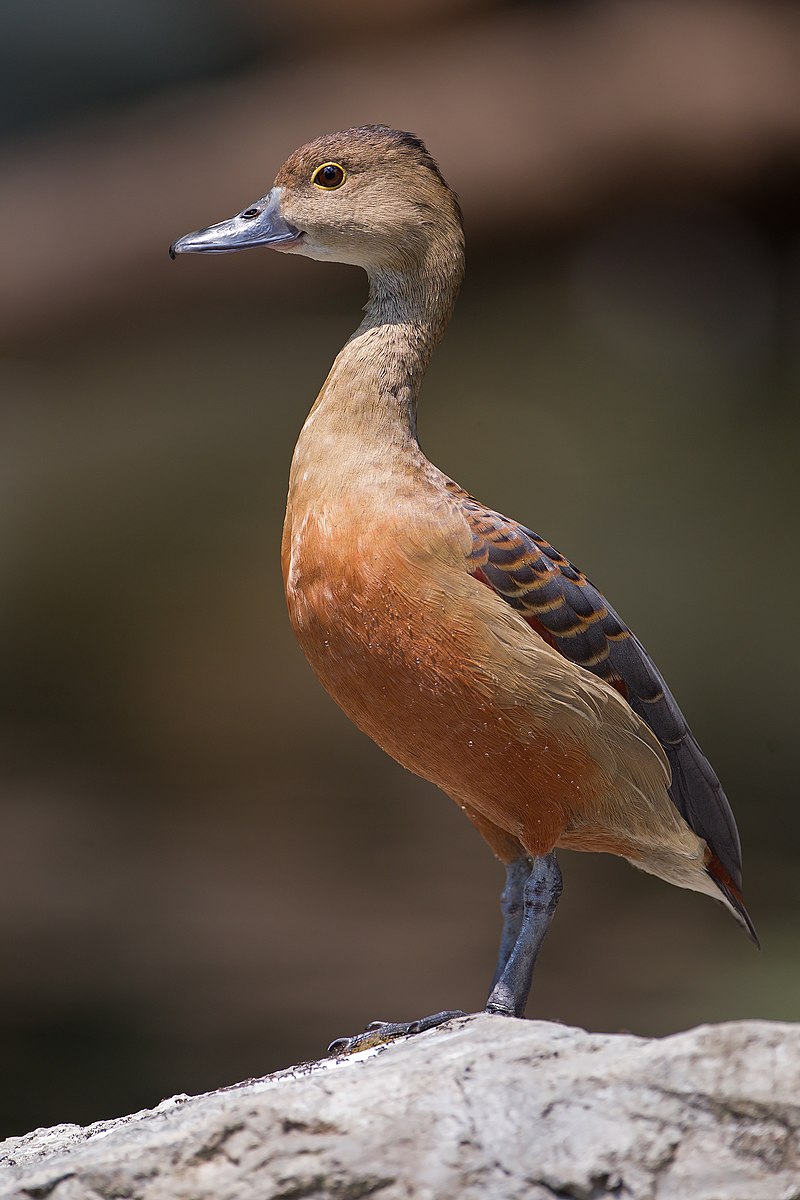
The Lesser Whistling Duck is a species of whistling duck found in the Indian subcontinent and Southeast Asia.
It has an unmistakable appearance, with its brown body, white-streaked wings and distinctive black tail feathers.
The adult ducks have red bills, eyes and legs with yellowish webbed feet for swimming.
They are generally nocturnal feeders but during the day they can be seen around lakes or wet paddy fields in flocks perching on trees or even building their nest inside tree hollows.
Their diet mainly consists of seeds from aquatic plants as well as small fish, mollusks and insects occasionally taken while wading or diving into water bodies to find food sources.
Scientific classification:
| Kingdom | Animalia |
| Phylum | Chordata |
| Class | Aves |
| Order | Anseriformes |
| Family | Anatidae |
| Genus | Dendrocygna |
| Species | D. javanica |
Also Featured In: Most Common Birds of Ko Samui, Ko Samet Birds You Need To Know
3. Indian Roller
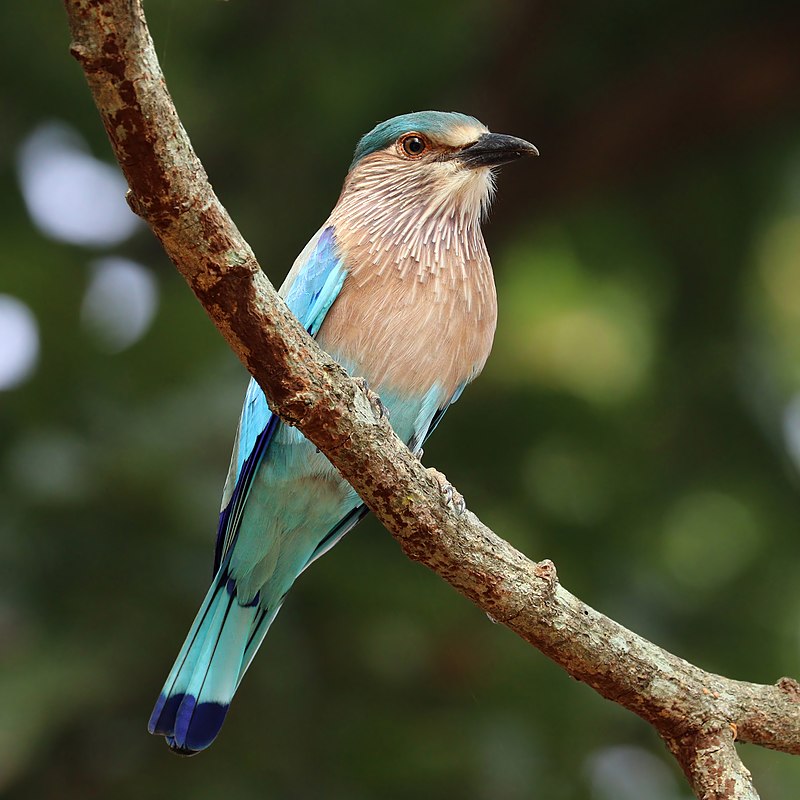
The Indian roller is a beautiful bird of the Coraciidae family. It has an average length of 12-13 inches and weighs 5.9 to 6.2 ounces with a wingspan of 26-29 inches.
Its face and throat are pinkish, while its head and back are brown with blue on its rump, light blue markings on one side of the wing, dark blue markings on other side making it easily distinguishable in flight.
Both male and female have same colouration but males tend to be slightly larger than females though they can only be differentiated when seen together closely due to similar colouring pattern between sexes.
The Indian Roller makes spectacular aerial dives from great heights during courtship display which attracts many viewers each year.
Scientific classification:
| Kingdom | Animalia |
| Phylum | Chordata |
| Class | Aves |
| Order | Coraciiformes |
| Family | Coraciidae |
| Genus | Coracias |
| Species | C. benghalensis |
Also Featured In: Common Birds in India, Birds That You’ll See in Kaziranga National Park
4. Red-Wattled Lapwing
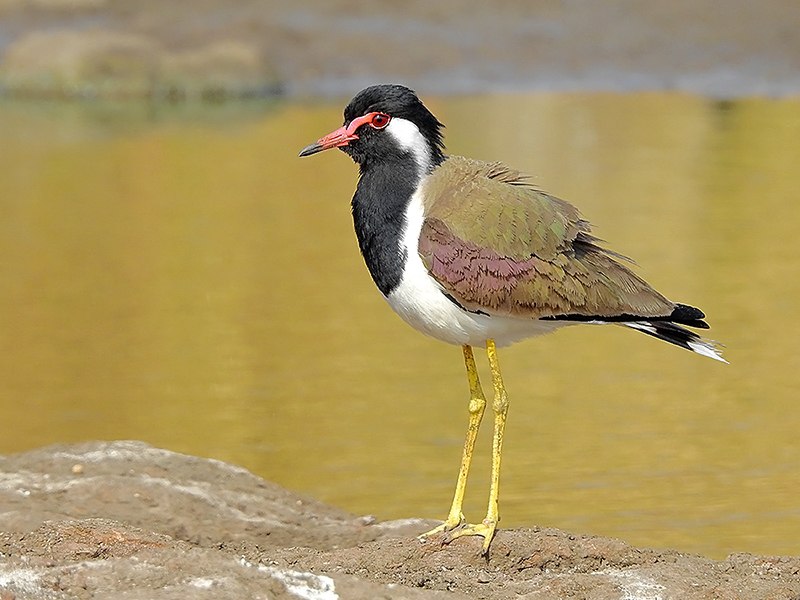
The Red-wattled Lapwing is an Asian bird belonging to the family Charadriidae. It has a distinctive loud call which led to it being nicknamed ‘did he do it’ by locals, due to its sound resembling the phrase.
These birds are usually found on open ground and cannot perch like other lapwings. They have black feathers with white wings, back and tail along with reddish wattles near their eyes that give them their name.
Red-wattled Lapwings feed mainly on insects but also eat some plant matter such as seeds or grains.
During breeding season they form strong pair bonds and make nests in shallow depressions of sand or soil lined with vegetation for incubating eggs during mating season before hatching out young chicks in around 25 days after laying eggs.
Scientific classification:
| Kingdom | Animalia |
| Phylum | Chordata |
| Class | Aves |
| Order | Charadriiformes |
| Family | Charadriidae |
| Genus | Vanellus |
| Species | V. indicus |
Also Featured In: Birds that Live in Uttar Pradesh, Birds of Konkan
5. Yellow-Wattled Lapwing
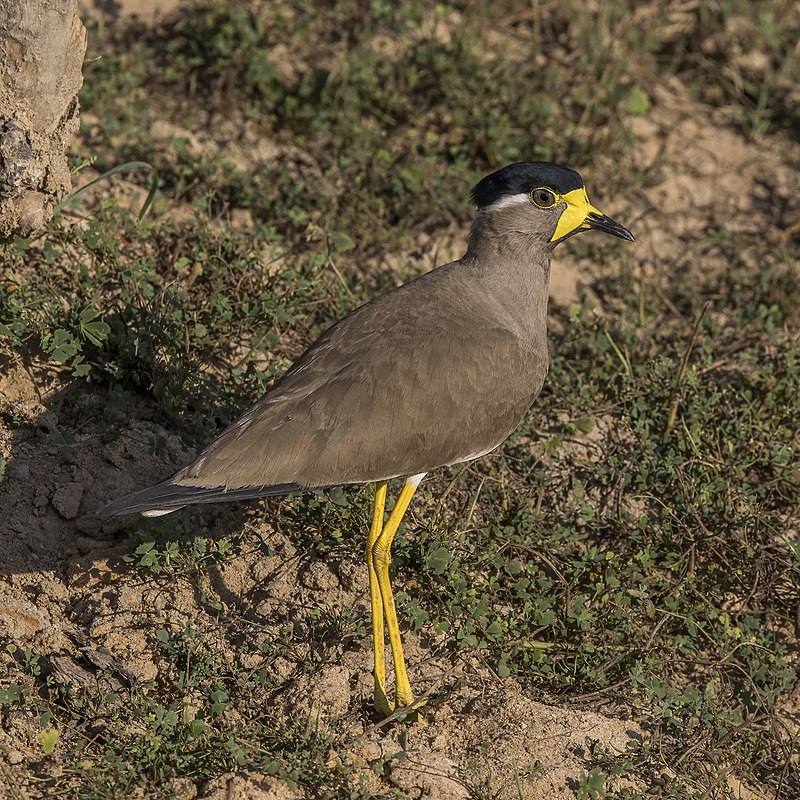
The Yellow-wattled Lapwing is a stunning bird native to the Indian Subcontinent. It has an unmistakable appearance, with its grey brown body and black cap contrasting sharply against its bright yellow legs and triangular wattle at the base of its neck.
Not only does this make it easily identifiable, but also makes it quite attractive in appearance.
The bird is capable of fast flight and has a sharp call which can be heard over long distances on dry plains across peninsular India.
Although they don’t migrate, they do make seasonal movements depending on rainfall patterns in their locale making them adaptive birds too.
Scientific classification:
| Kingdom | Animalia |
| Phylum | Chordata |
| Class | Aves |
| Order | Charadriiformes |
| Family | Charadriidae |
| Genus | Vanellus |
| Species | V. malabaricus |
6. Asian Openbill
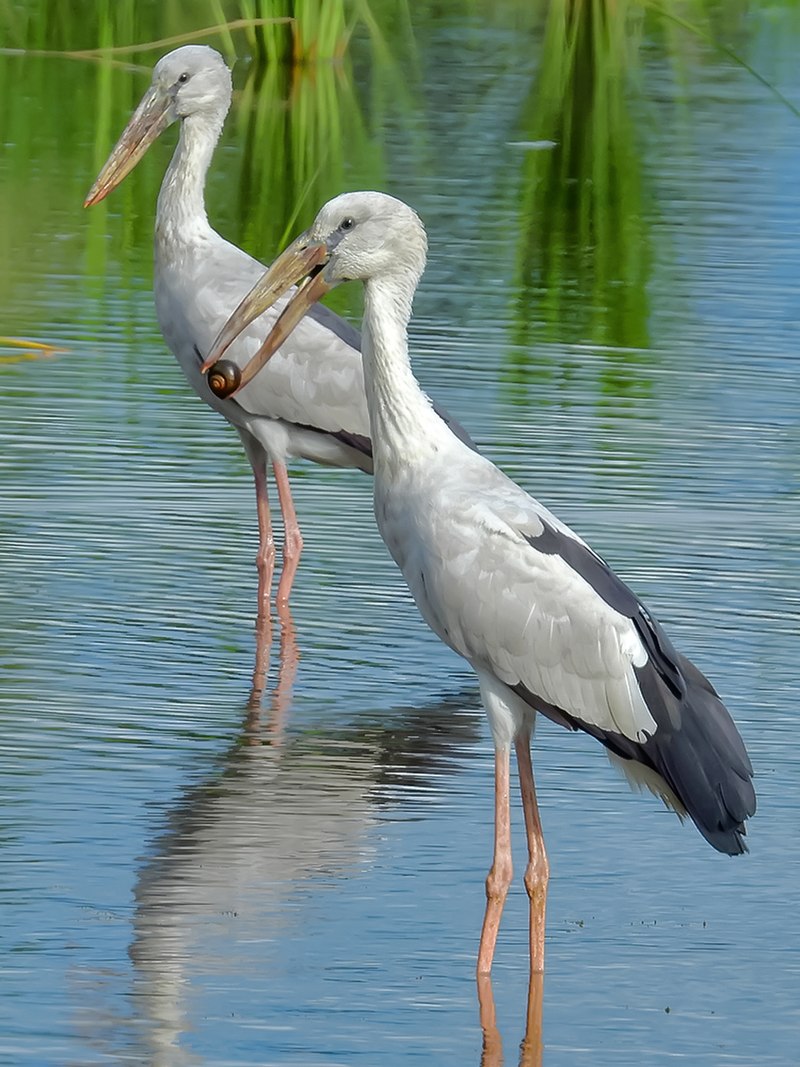
The Asian openbill is a large stork found in the Indian subcontinent and Southeast Asia. It has a greyish or white body, glossy black wings and tail, with an adult having a gap between upper mandible and lower one.
Juveniles don’t have this unique feature but will grow it as they mature.
They feed by wading through shallow water looking for snails, crustaceans and aquatic plants to eat from the surface of mudflats or marshes.
Due to its enormous size (up to 121 cm tall) it makes quite an impressive sight when flying.
Scientific classification:
| Kingdom | Animalia |
| Phylum | Chordata |
| Class | Aves |
| Order | Ciconiiformes |
| Family | Ciconiidae |
| Genus | Anastomus |
| Species | A. oscitans |
Also Featured In: Big Birds that Live in Singapore,
7. Yellow-Footed Green Pigeon
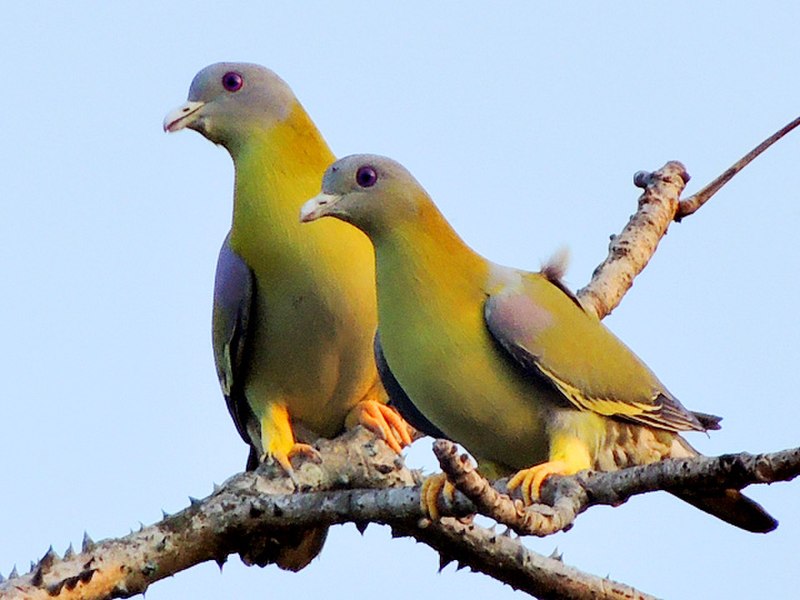
The Yellow-footed Green Pigeon is a common species of green pigeon found in the Indian subcontinent and parts of Southeast Asia. It has yellow feet and legs, with emerald green body plumage that stands out from its surroundings.
This vibrant bird is also the state bird of Maharashtra, where it’s called “Haroli” or “Hariyal”. Its diet consists mainly of fruit like Ficus racemosa, Terminalia arjuna, Syzygium cumini etc., which are important sources for wild animals.
With their impressive vocalizations and adaptability to different environments they have become popular among city dwellers as well.
The Yellow-footed Green Pigeon plays an important role in maintaining healthy ecosystems by providing food to other wildlife while dispersing seeds through defecation – helping propagate new plants across vast areas.
Scientific classification:
| Kingdom | Animalia |
| Phylum | Chordata |
| Class | Aves |
| Order | Columbiformes |
| Family | Columbidae |
| Genus | Treron |
| Species | T. phoenicopterus |
8. Indian Grey Hornbill
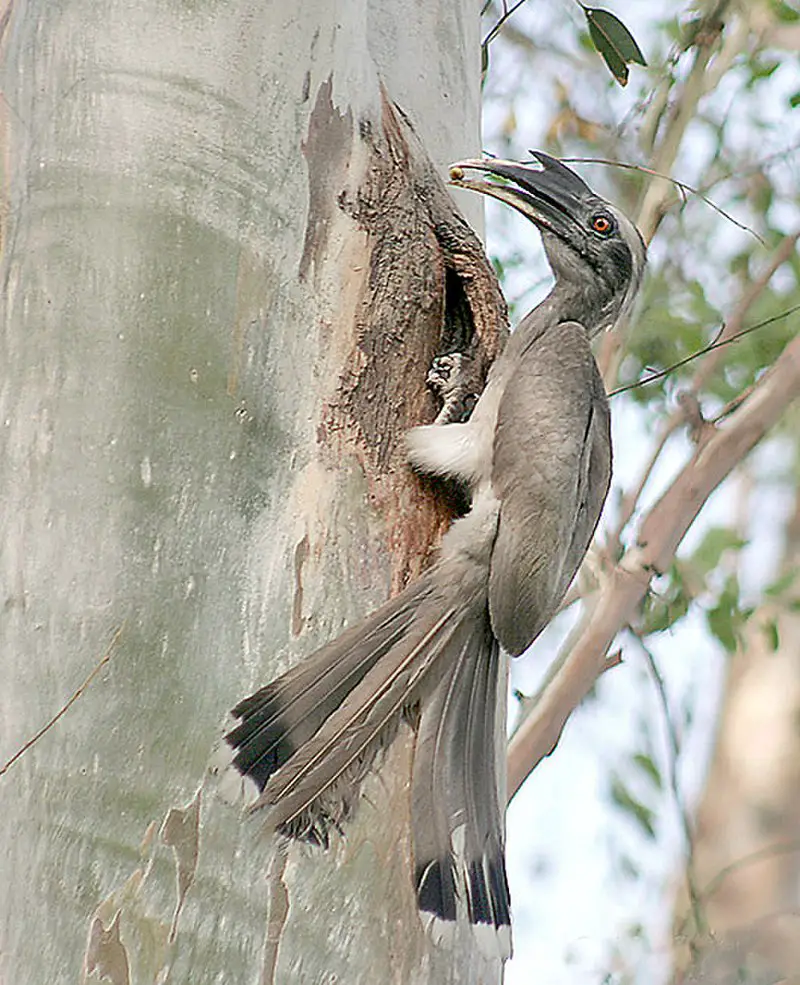
The Indian gray hornbill is a common bird found throughout the Indian subcontinent. It has grey feathers covering its body and a light grey or dull white belly.
Its distinctive feature is an iconic black or darkly-colored horn with a casque extending to the point of curvature on top of it’s head.
They are mostly arboreal, often seen in pairs, and can even be spotted in urban areas across India.
The diet consists mainly of fruit such as figs along with seeds, small reptiles and insects too.
Their loud calls help them communicate over long distances making them easily identifiable within their habitat range
Scientific classification:
| Kingdom | Animalia |
| Phylum | Chordata |
| Class | Aves |
| Order | Bucerotiformes |
| Family | Bucerotidae |
| Genus | Ocyceros |
| Species | O. birostris |
Also Featured In: Native Pakistani Birds,
9. Rufous Treepie
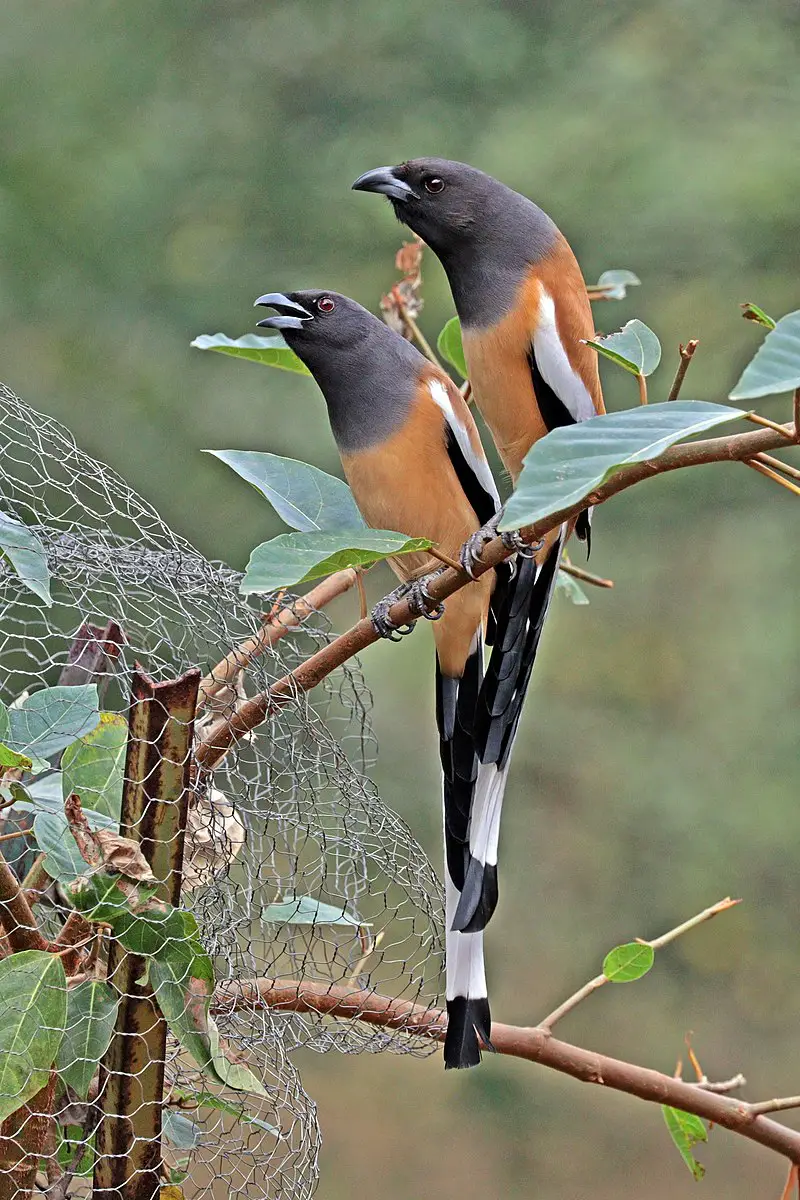
The Rufous Treepie is a member of the Corvidae family and native to the Indian Subcontinent, as well as parts of Southeast Asia. It has distinctive loud musical calls that make it easily recognizable.
This bird can be found in open scrub lands, agricultural areas, forests and even urban gardens due to its adaptability and omnivorous diet.
With its long tail feathers ranging from brown-black to greyish-brown on top with orange underneath; this species stands out among other birds.
They also have an interesting way of eating fruits: they peck at them while hovering midair. The Rufous Treepie is not only beautiful but also quite intelligent – their problem solving abilities are second only to those of primates.
Scientific classification:
| Kingdom | Animalia |
| Phylum | Chordata |
| Class | Aves |
| Order | Passeriformes |
| Family | Corvidae |
| Genus | Dendrocitta |
| Species | D. vagabunda |
Also Featured In: Most Common Birds of Bihar,
10. White-Eyed Buzzard
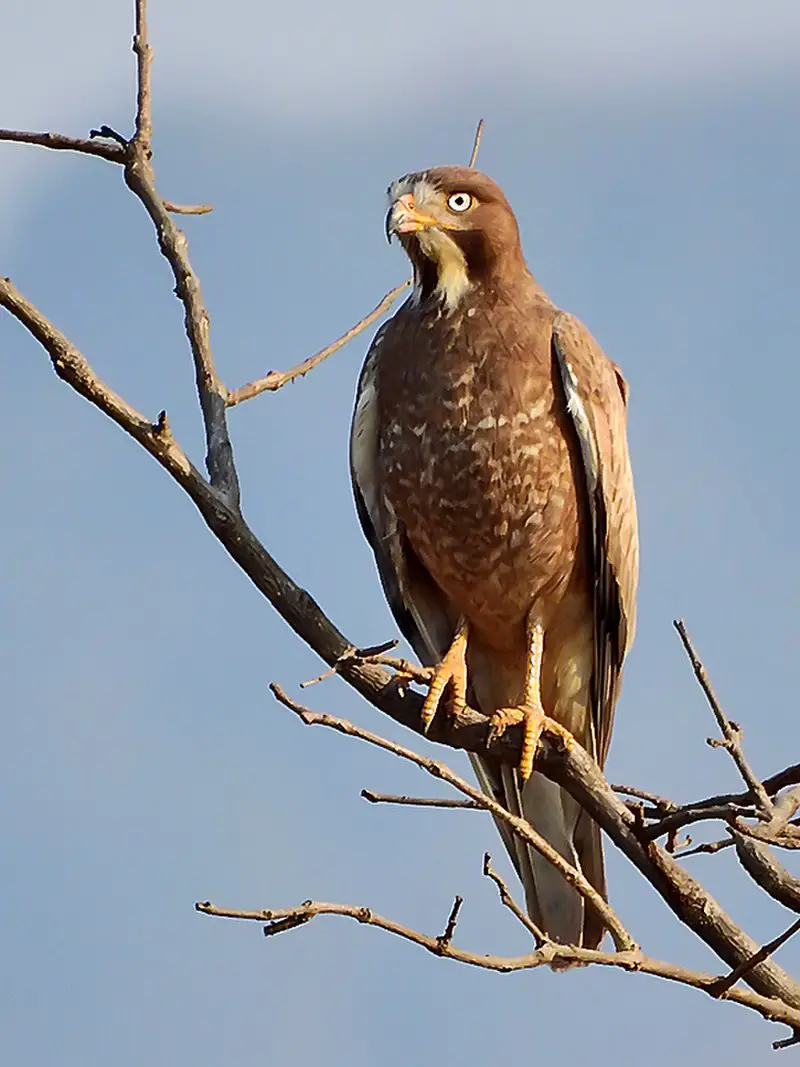
The White-eyed Buzzard is a medium-sized hawk found in South Asia. It has a brown head, rufous tail and distinctive white iris.
Its throat bears a dark mesial stripe bordered by white feathers, while its upper wing holds pale median coverts.
Unlike true buzzards, the underside of their wings don’t have carpal patches.
They feed on small mammals such as rodents and lizards; they also consume snakes and large insects like locusts or grasshoppers.
These birds build stick nests high up in trees for breeding purposes; usually laying one to two eggs at once which are incubated over 4 weeks .
The chicks fledge after about 6 weeks but will stay with their parents until the next breeding season begins when they become independent adults that can live up to 10 years old.
Scientific classification:
| Kingdom | Animalia |
| Phylum | Chordata |
| Class | Aves |
| Order | Accipitriformes |
| Family | Accipitridae |
| Genus | Butastur |
| Species | B. teesa |
11. Cinnamon Bittern
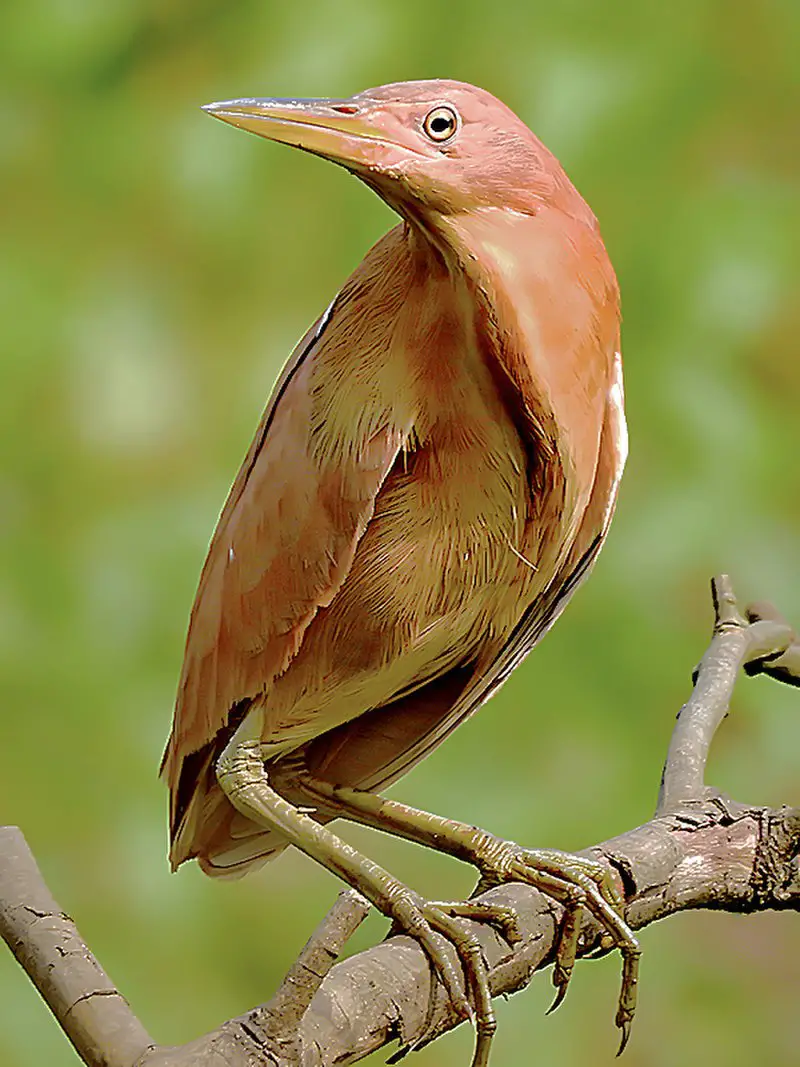
The Cinnamon Bittern is a small Old World bird, found in parts of India, China and Indonesia. It can be identified by its chestnut brown colour on the back and wings with white streaks throughout.
During breeding season it has yellowish-brown plumage on its head neck and breast. Its legs are black which helps distinguish it from other bitterns.
The cinnamon bittern mainly resides in tropical or subtropical climates but some northern birds migrate short distances during winter months for food sources.
They feed mostly on fish, insects, frogs and crustaceans while they breed between April to August making nests near shallow water areas under dense vegetation cover providing safety from predators like snakes or cats that may prey upon them otherwise.
Scientific classification:
| Kingdom | Animalia |
| Phylum | Chordata |
| Class | Aves |
| Order | Pelecaniformes |
| Family | Ardeidae |
| Genus | Ixobrychus |
| Species | I. cinnamomeus |
Also Featured In: Birds that Commonly Found in Bali,
12. Blue-Eared Kingfisher
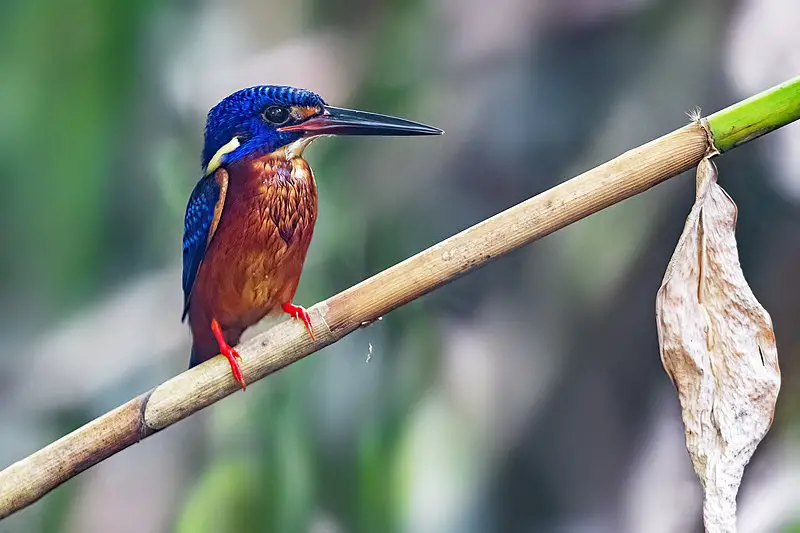
The Blue-eared Kingfisher is a beautiful species of bird found mainly in the dense forests across India and Southeast Asia.
Its distinguishing features include its darker crown, dark rufous underparts, and lack of the typical red ear stripe seen on other kingfishers such as Alcedo atthis which usually inhabit more open environments.
There are different subspecies identified by researchers due to slight variations in size or colouration present within this species.
The Blue-eared Kingfisher feeds mostly on small fish it catches while hunting along slow moving streams near shaded areas that provide plenty of cover from predators.
Not much else is known about these beautiful birds but they remain an important part of their local ecosystems.
Scientific classification:
| Kingdom | Animalia |
| Phylum | Chordata |
| Class | Aves |
| Order | Coraciiformes |
| Family | Alcedinidae |
| Subfamily | Alcedininae |
| Genus | Alcedo |
| Species | A. meninting |
Also Featured In: Most Common Types of Bangladeshi Birds,
13. Brown Fish Owl
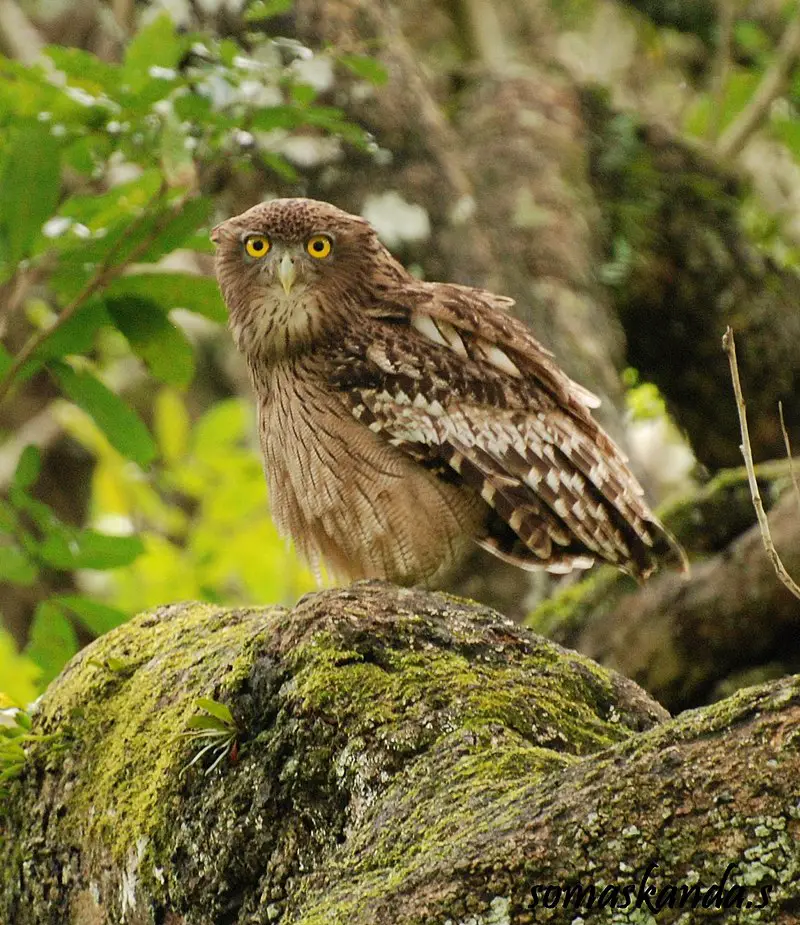
The Brown Fish Owl is a species of owl found in Turkey, South and Southeast Asia. It inhabits forests and wooded wetlands with its wide distribution leading to it being categorized as least concern on the IUCN Red List.
Of all four living fish owl species, this one is the most abundant, widespread and studied. Its diet consists mainly of fish but also small mammals or reptiles when available.
They usually hunt from perches near water sources waiting for their prey before swooping down to capture them using powerful talons between dusk until dawn.
These birds are monogamous with pairs staying together throughout the year while raising their young which hatch after 30 days of incubation by both parents in tree hollows or rock crevices close to streams or lakesides where they can easily find food for themselves and their offspring
Scientific classification:
| Kingdom | Animalia |
| Phylum | Chordata |
| Class | Aves |
| Order | Strigiformes |
| Family | Strigidae |
| Genus | Ketupa |
| Species | K. zeylonensis |
14. Vernal Hanging Parrot
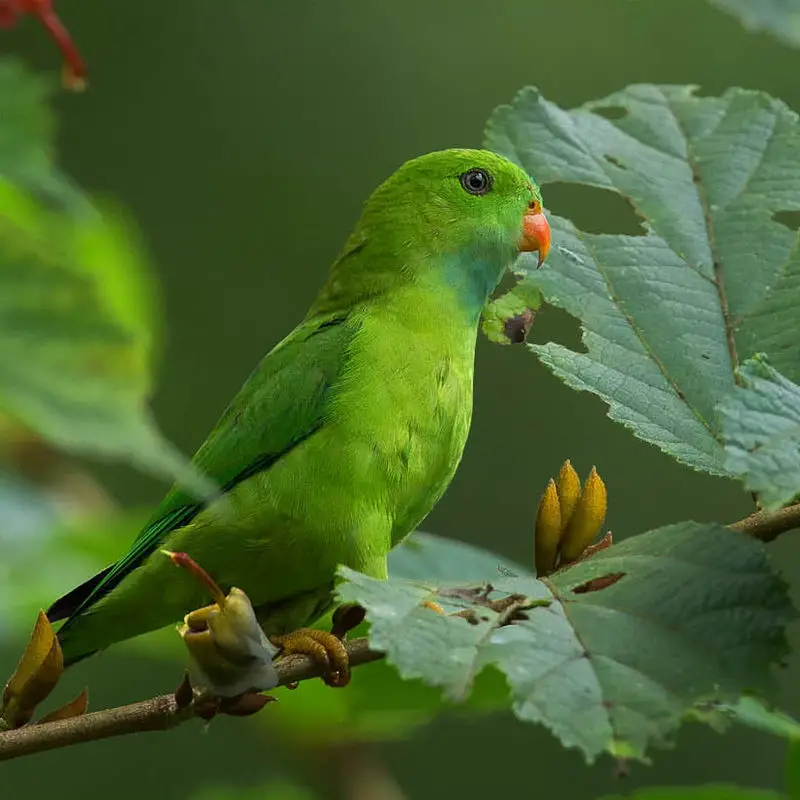
The Vernal hanging parrot is a small, colourful bird native to the Indian subcontinent and parts of Southeast Asia. It has bright green feathers with black edging above its wings and tail, while its chest and belly are yellow-green in colour.
They feed mainly on fruit, seeds, buds and blossoms which they find by frequenting banyan trees for their fruits as well as plantain trees for nectar from flowers.
Although it typically stays within one area throughout the year there have been occasions where this species will move around due to changes in food availability or seasonality.
As such these birds can be found across various habitats including forests, woodlands and urban areas too.
Scientific classification:
| Kingdom | Animalia |
| Phylum | Chordata |
| Class | Aves |
| Order | Psittaciformes |
| Family | Psittaculidae |
| Genus | Loriculus |
| Species | L. vernalis |
Also Featured In: Pet Birds that Live in India, Birds Live In Koh Kood
15. Whiskered Tern
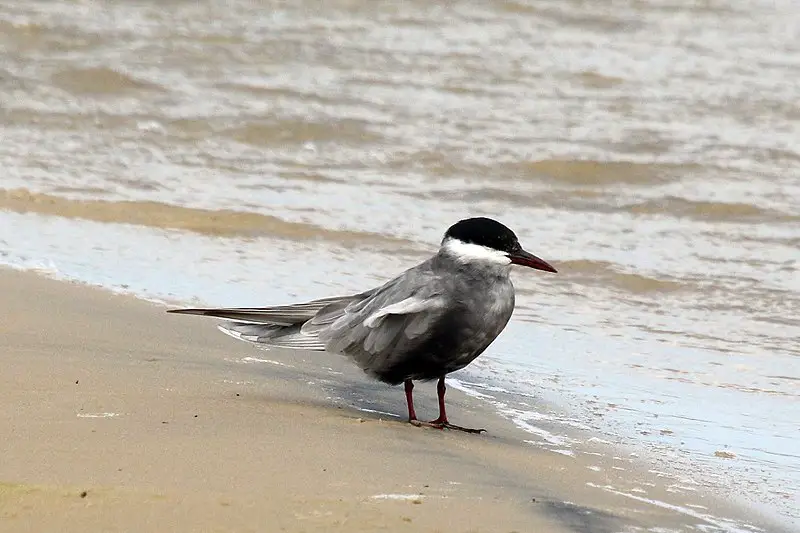
The whiskered tern (Chlidonias hybrida) is a small, graceful bird belonging to the family Laridae, which includes gulls, terns, and skimmers.
This bird is widely distributed across Europe, Asia, and Africa, where it breeds in colonies in freshwater marshes, ponds, and lakeshores.
The whiskered tern has a distinctive appearance, resembling a swallow, with a short, forked tail, black cap, and white cheeks.
One of the most distinctive features of the whiskered tern is its bill, which is strong and pointed. This adaptation allows it to catch insects and small fish, which make up the bulk of its diet.
During the breeding season, the whiskered tern’s bill and legs turn bright red, adding to its striking appearance.
The whiskered tern is a highly adaptable bird, and as such, it is found in various races across its range. For example, in Europe, it breeds mainly in western and southern countries, while in Asia, it breeds from the Middle East to the Russian Far East.
The whiskered tern is also a migrant bird, with populations wintering in sub-Saharan Africa, India, Southeast Asia, and Australia.
Breeding season for the whiskered tern is between May and August, and the birds form colonies with hundreds or thousands of individuals. They build their nests on floating vegetation or on the ground, and both sexes share incubation duties.
The chicks hatch after about three weeks, and the parents feed them insects and small fish until they are ready to fly after about three more weeks.
Although the whiskered tern is not considered threatened, its populations have declined in some areas, primarily due to habitat loss and degradation.
The destruction of wetlands, pollution, and changes in water levels and quality have all had an impact on the bird’s breeding and feeding grounds.
Scientific classification:
| Kingdom | Animalia |
| Phylum | Chordata |
| Class | Aves |
| Order | Charadriiformes |
| Family | Laridae |
| Genus | Chlidonias |
| Species | C. hybrida |
Also Featured In: Most common Birds in France, Common Serbian Birds
16. River Lapwing
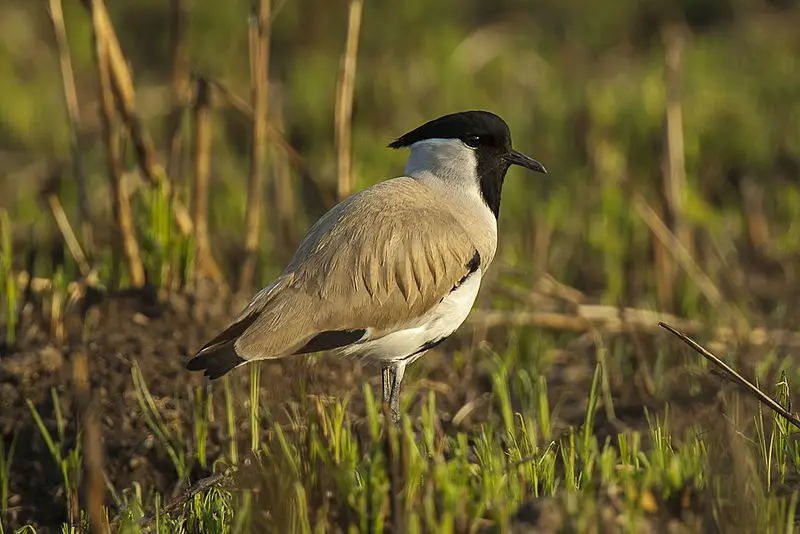
The River Lapwing is a striking black and white bird with long legs and an orange crest upon its head. It can be found throughout much of northern India as well as parts of Southeast Asia, including Vietnam.
This species rarely migrates and tends to stay in the same general area year-round.
The river lapwing has unique features that make it stand out from other birds, such as its bright yellow eyes, short bill, large wingspan for better flight stability, spur-like feathers on its inner wing joints which are used for protection against predators or rivals during mating season.
Despite being quite beautiful when seen up close, this species often goes unnoticed due to their small size; they typically measure between 25 – 28 cm long.
Scientific classification:
| Kingdom | Animalia |
| Phylum | Chordata |
| Class | Aves |
| Order | Charadriiformes |
| Family | Charadriidae |
| Genus | Vanellus |
| Species | V. duvaucelii |
Also Featured In: Birds of Myanmar, Birds that Live in Uttarakhand
17. Great Stone-Curlew
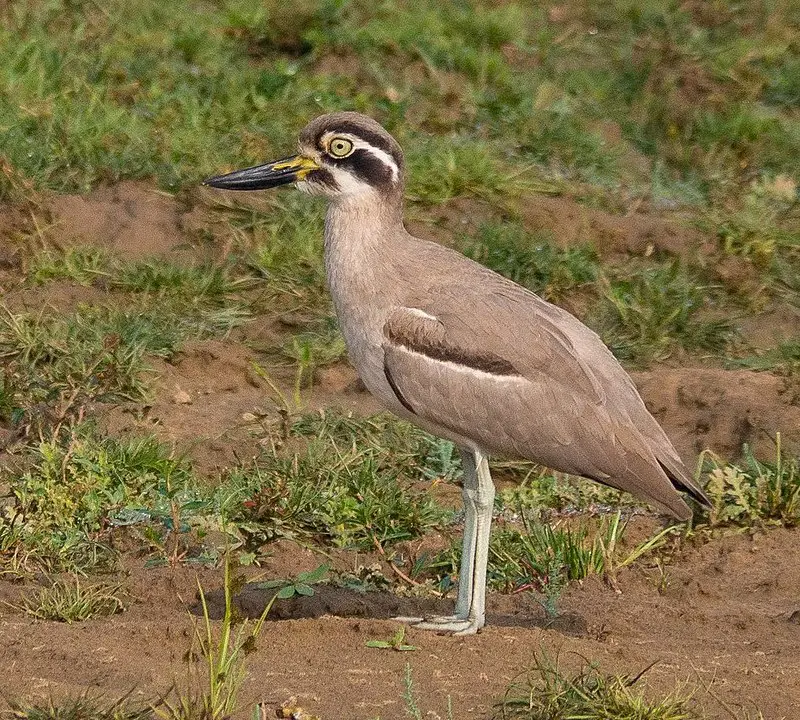
The Great Stone-Curlew, also known as the great thick-knee, is a large wader found in tropical southern Asia. It stands out with its long yellow legs and brownish plumage.
This bird was first described by French naturalist Georges Cuvier in 1829 who gave it the scientific name Oedicnemus recurvirostris, with Nepal being its type locality.
The species prefers to inhabit open country like steppes or grasslands where they hunt for prey on foot during night time while keeping watch from high perches during daybreak.
They are monogamous birds that breed between April – June and form strong pair bonds throughout their lifetime.
Scientific classification:
| Kingdom | Animalia |
| Phylum | Chordata |
| Class | Aves |
| Order | Charadriiformes |
| Family | Burhinidae |
| Genus | Esacus |
| Species | E. recurvirostris |
Also Featured In: Urban Birds of Hong Kong,
18. Black-Hooded Oriole
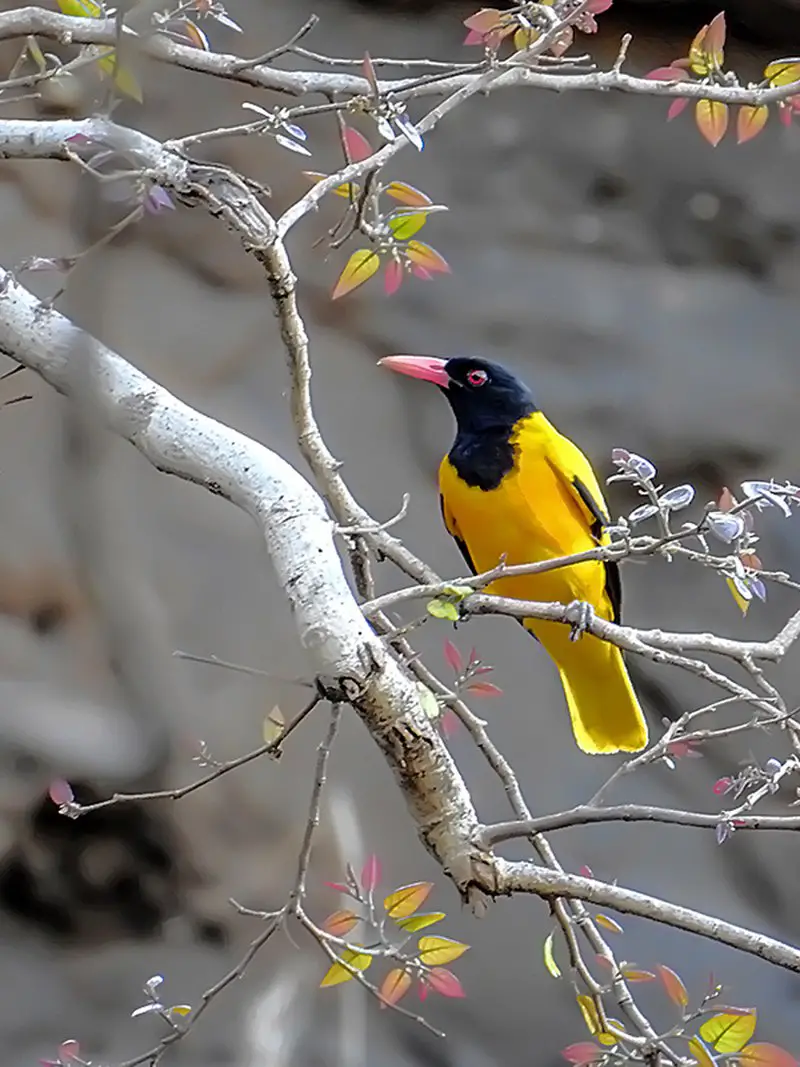
The Black-hooded Oriole is a beautiful and unique bird found in tropical southern Asia. It has black feathers on its head, giving it the name “black hooded”.
Its diet consists of insects, fruit, especially figs which can be found in the tree canopy where they spend most of their time. They build nests high up on trees to lay their eggs – usually two per nest.
The orioles are active during daybreak and nightfall when they search for food or mates. Their bright colors make them noticeable even from afar making them an interesting sight for any nature lover with a keen eye.
Scientific classification:
| Kingdom | Animalia |
| Phylum | Chordata |
| Class | Aves |
| Order | Passeriformes |
| Family | Oriolidae |
| Genus | Oriolus |
| Species | O. xanthornus |
Also Featured In: Common Birds Found in Nepal, Birds that You’ll Find in Kruger national park
19. Bar-Winged Flycatcher-Shrike
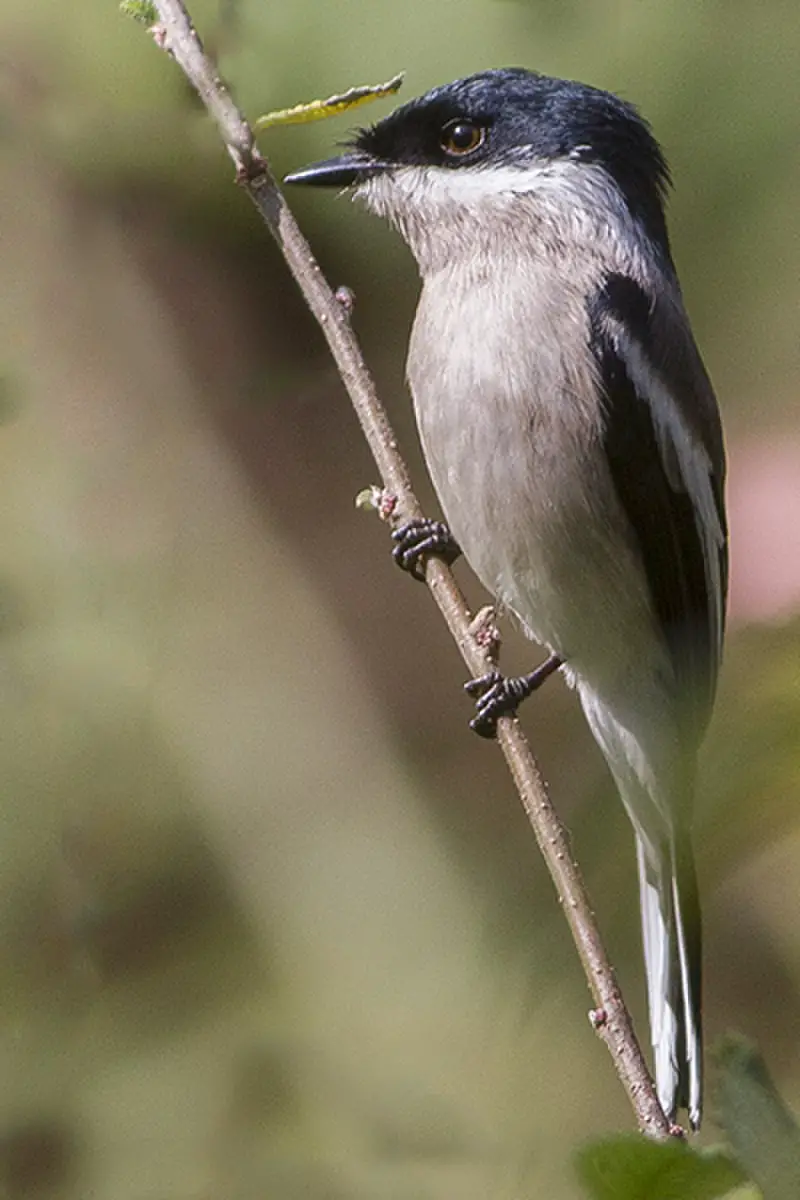
The Bar-winged Flycatcher-Shrike is a small passerine bird found in the forests of tropical southern Asia, ranging from the Himalayas and hills of India to Indonesia.
These birds inhabit mid-canopy levels in the forest, often joining mixed species flocks while they search for food.
With its distinctive pattern of black and white plumage on its head and wings, this flycatcher can be easily identified by experienced bird watchers.
They are mainly insectivorous birds that feed upon insects such as moths, beetles and flies which they capture using their sharp bill or talons during flight.
The bar-winged flycatcher has adapted well to life in these woodlands with an agile nature allowing it to navigate quickly through dense foliage when searching for prey or evading predators.
Scientific classification:
| Kingdom | Animalia |
| Phylum | Chordata |
| Class | Aves |
| Order | Passeriformes |
| Family | Vangidae |
| Genus | Hemipus |
| Species | H. picatus |
Also Featured In: Birds that Live in Kuala Lumpur, Birds that Commonly Found in Andhra Pradesh
20. Orange-Breasted Green Pigeon
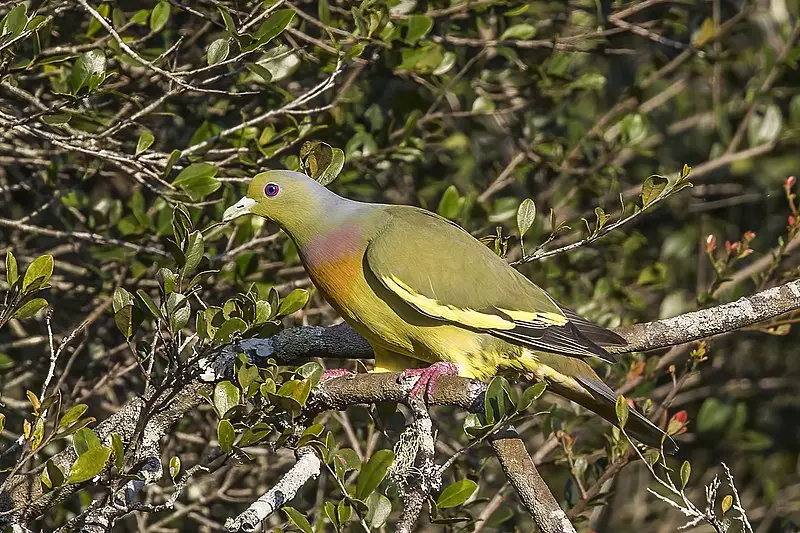
The Orange-breasted green pigeon is a small bird found across tropical Asia, mainly in the Indian Subcontinent and Southeast Asia.
Generally seen in pairs or small flocks, these birds are known for their quiet demeanor while foraging on trees.
They have blue-grey napes with yellowish green crowns, orange breast feathers along with grey wings and tails.
These pigeons predominantly feed on ripe fruits but also consume nuts and seeds to supplement their diet occasionally.
Due to habitat destruction caused by human activities such as logging of forests, this species has been classified as Near Threatened according to IUCN Red List Criteria from 2006 onwards.
Scientific classification:
| Kingdom | Animalia |
| Phylum | Chordata |
| Class | Aves |
| Order | Columbiformes |
| Family | Columbidae |
| Genus | Treron |
| Species | T. bicinctus |
Also Featured In: Birds in Sri Lanka,
21. Black-Naped Monarch
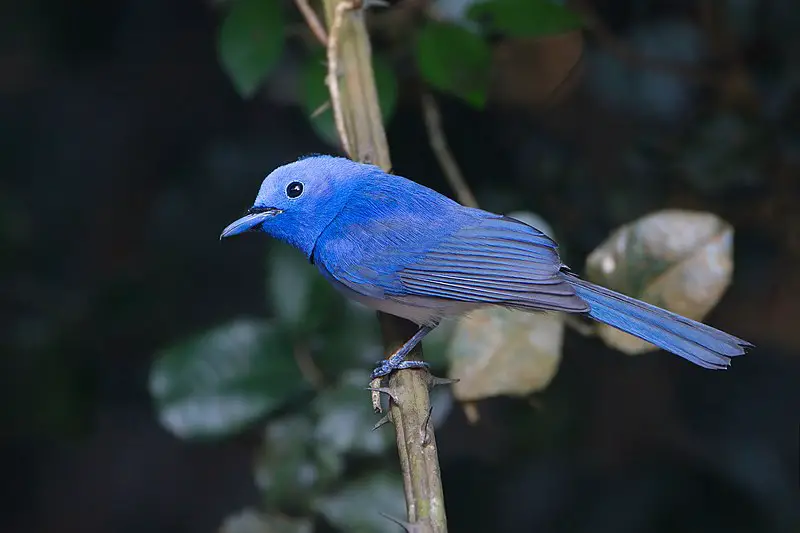
The Black-naped Monarch is a beautiful and agile passerine bird native to Southern and South East Asia.
With its distinct black patch on the back of it’s head, this small but strong species stands out among other birds in the area.
The male has vibrant blue plumage with an elegant narrow black half collar (“necklace”) which makes him even more attractive.
Females are comparatively duller with olive brown wings and light yellowish underparts which helps them blend into their environment better for camouflage purposes.
These birds feed mainly on insects, spiders and fruits making them beneficial as they help reduce pests while also providing nutrients to local vegetation by dispersing seeds from fruit consumption.
Scientific classification:
| Kingdom | Animalia |
| Phylum | Chordata |
| Class | Aves |
| Order | Passeriformes |
| Family | Monarchidae |
| Genus | Hypothymis |
| Species | H. azurea |
Also Featured In: Singapore Birds, Common Birds of Lombok
22. Grey-Headed Lapwing
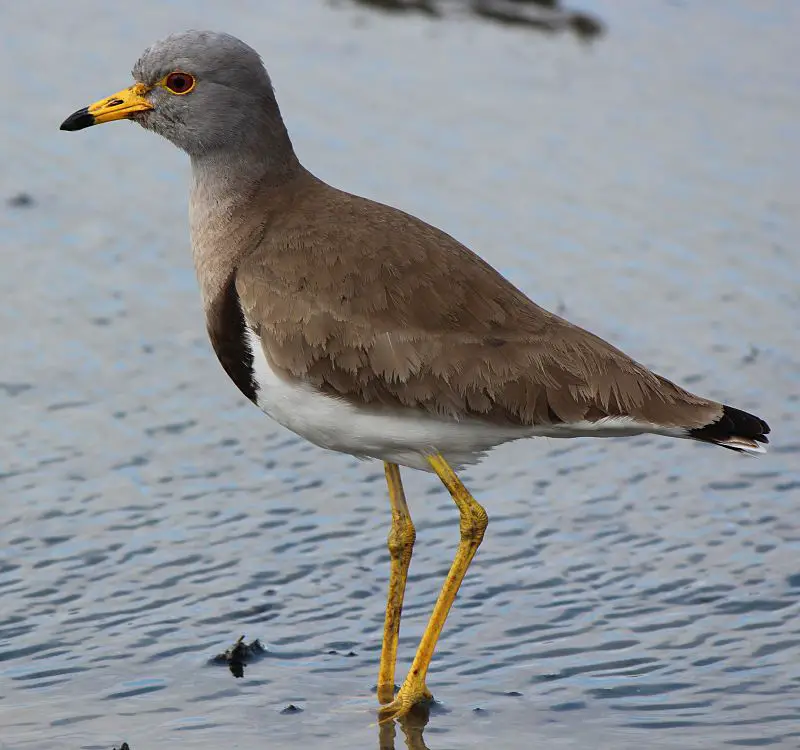
The Grey-headed Lapwing is a bird native to northeast China and Japan. During the winter season, they migrate to northern Southeast Asia from India all the way down to Cambodia.
The Japanese population has been known to spend some of their time in southern Honshū during this period as well.
It’s also classed as a vagrant species in several other countries such Russia, Philippines, Indonesia, Australia and Sri Lanka too.
This lovely little lapwing has grey feathers on its head along with white around its face and neck area which makes it easy for people to identify them if spotted out in nature.
They feed mainly off insects but have occasionally been seen eating plants or small seeds now and then too.
Scientific classification:
| Kingdom | Animalia |
| Phylum | Chordata |
| Class | Aves |
| Order | Charadriiformes |
| Family | Charadriidae |
| Genus | Vanellus |
| Species | V. cinereus |
Also Featured In: Flight Birds You Should Know, Most Common Birds Live in Osaka
23. Indian Silverbill
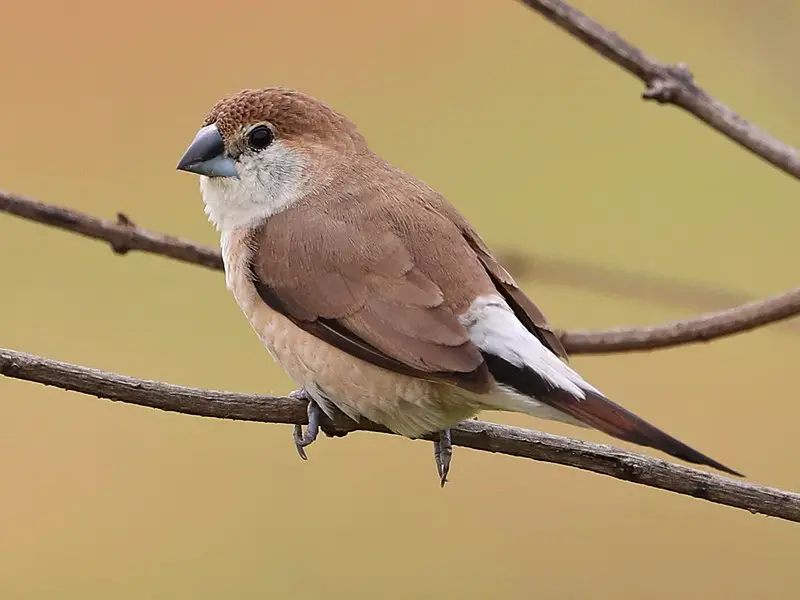
The Indian silverbill is a small passerine bird found in the Indian Subcontinent and adjoining regions.
It has grey upperparts, white underparts with black barring on its breast and abdomen, bluish-white wings and tail feathers; Males have bright red eyes while females have brownish eyes.
This estrildid finch species inhabits dry areas of the Middle East region as well as the subcontinent where it breeds commonly.
The diet of this species consists mainly of grass seeds supplemented by insects during breeding season.
Although they are not known to be migratory birds, they may flock together when food sources become scarce in their native range due to drought or other environmental conditions.
They can also now be found outside their natural range following introductions from humans for aviculture purposes
Scientific classification:
| Kingdom | Animalia |
| Phylum | Chordata |
| Class | Aves |
| Order | Passeriformes |
| Family | Estrildidae |
| Genus | Euodice |
| Species | E. malabarica |
Also Featured In: Oman Birds, Silver Birds You Should Know
24. Thick-Billed Flowerpecker
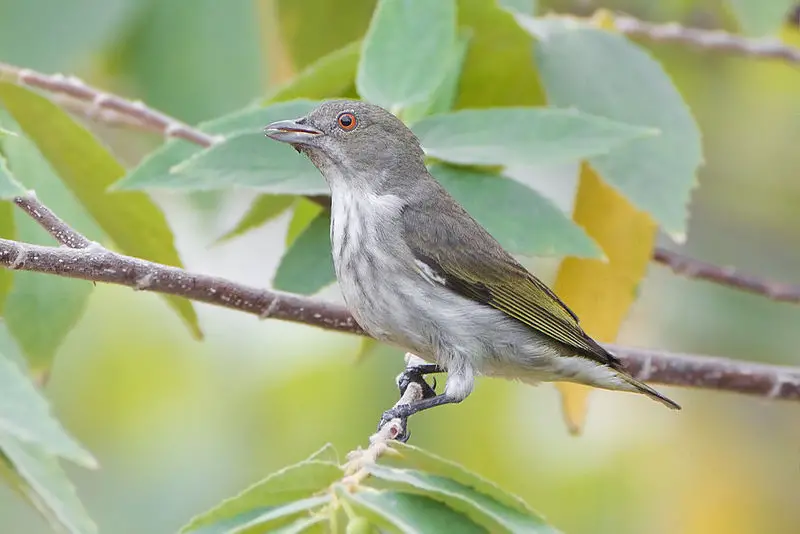
The Thick-billed Flowerpecker is a tiny bird that belongs to the flowerpecker group. It has a wide distribution across tropical southern Asia, ranging from India east to Indonesia and Timor.
They are active birds found in the tops of trees in forests and they predominantly feed on fruits.
This species is also considered as resident with several populations recognized as subspecies, some of which may be treated as their own separate species at times.
These little birds have bright plumage making them quite attractive while they search for food amongst tree canopies or fly around looking for insects or nectar sources.
Scientific classification:
| Kingdom | Animalia |
| Phylum | Chordata |
| Class | Aves |
| Order | Passeriformes |
| Family | Dicaeidae |
| Genus | Dicaeum |
| Species | D. agile |
Also Featured In: Timor-Leste birds, Palawan Island Birds
25. Ashy Woodswallow
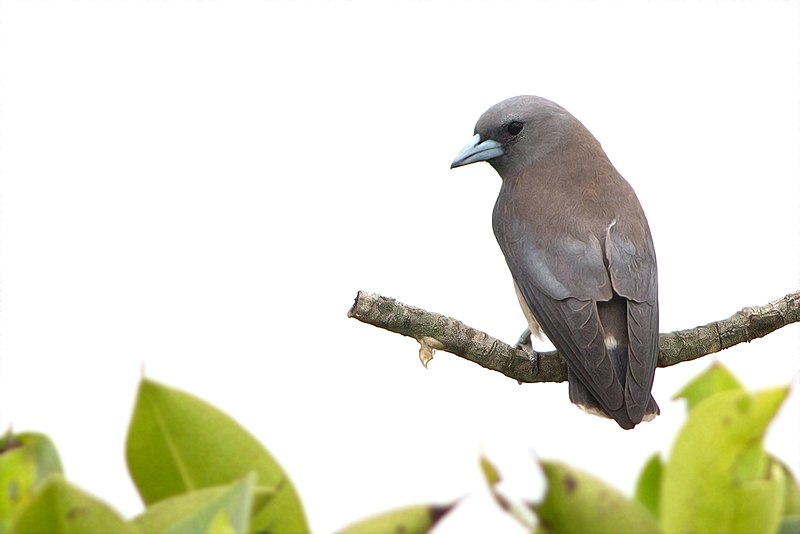
The Ashy Woodswallow is a small bird found in South Asia. It has a short, curved bill and long wings that make it appear stocky when perched.
This species of woodswallow typically spends time high on power lines or tall bare trees but can often be seen around palm tree-dominated areas too.
Their ashy gray coloration allows them to blend into the canopy making them difficult to spot at times.
They travel in groups and are very social birds who rely heavily on one another for protection from predators such as owls and falcons.
Despite their shyness, these fascinating little creatures are incredibly important pollinators of various plants across the region which makes protecting their habitats all the more essential.
Scientific classification:
| Kingdom | Animalia |
| Phylum | Chordata |
| Class | Aves |
| Order | Passeriformes |
| Family | Artamidae |
| Genus | Artamus |
| Species | A. fuscus |
Also Featured In: Maldives birds, Birds of Khao Yai National Park
26. Yellow Bittern
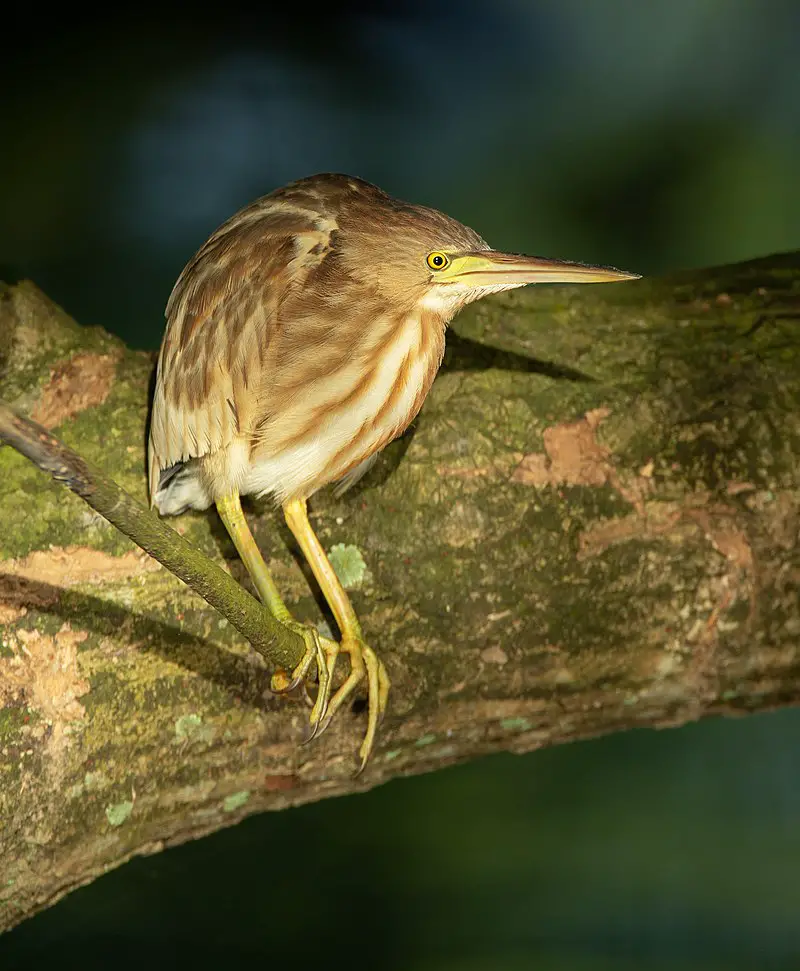
The yellow bittern is a small, Old World bird which breeds in parts of the Indian Subcontinent and East Asia. It can be found as far east as Russia and Japan, with some northern birds migrating short distances during winter.
This species has also been recorded as an unexpected vagrant to Alaska and Great Britain – one single sighting was documented at Radipole Lake in Dorset on November 23rd 1962.
Its feathers are primarily golden brown in colour, black streaks along its back contrasting against its bright chestnut-yellow neck patch; juvenile plumage appears duller but still shows distinctive markings.
Yellow bitterns feed mainly on fish or amphibians from shallow water sources such as marshes or swamps; they use their long bill to probe for prey hidden amongst reeds or grasses before seizing it quickly with their sharp talons.
Scientific classification:
| Kingdom | Animalia |
| Phylum | Chordata |
| Class | Aves |
| Order | Pelecaniformes |
| Family | Ardeidae |
| Genus | Ixobrychus |
| Species | I. sinensis |
Also Featured In: Herons Species, Guam Birds You Need to See
27. Black Bittern
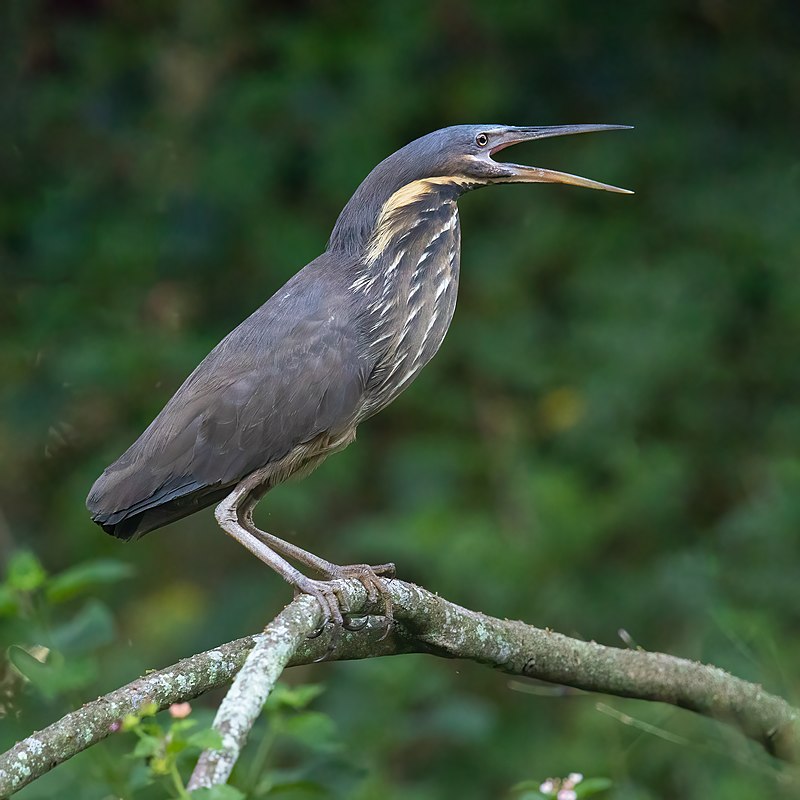
The Black Bittern is a large species of bird found in tropical Asia, stretching from Pakistan to China and Indonesia. It measures 58 cm (23 inches) long which makes it the largest bittern within its genus Ixobrychus.
The bird has black feathers on its back with white stripes running down either side, dark brown upper parts and yellow-brown underparts.
Its bill is short and thick while legs are greenish-yellow in color. They mainly reside where they breed but some northern birds migrate for shorter distances during winter seasons.
These birds feed upon fish, frogs, insects as well as small reptiles among other things making them omnivorous predators of their environment.
Scientific classification:
| Kingdom | Animalia |
| Phylum | Chordata |
| Class | Aves |
| Order | Pelecaniformes |
| Family | Ardeidae |
| Genus | Ixobrychus |
| Species | I. flavicollis |
Also Featured In: Birds of Karnataka, Common Birds of Chhattisgarh
28. Grey Francolin
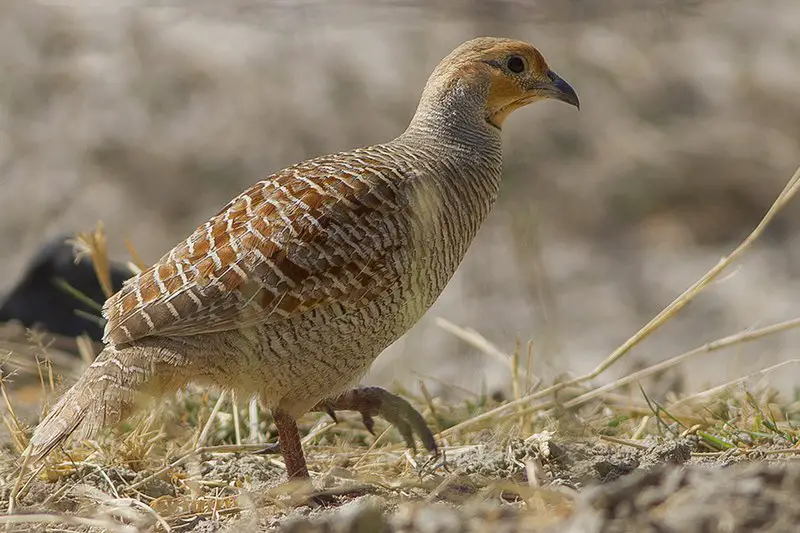
The Grey Francolin is a species of francolin found in the plains and drier parts of India, Iran and some other areas.
It was formerly called the grey partridge but should not be confused with European’s version.
This bird usually lives on ground where it finds open cultivated land. It has also been referred to as “manu moa” or “chicken bird”.
The colours can range from brownish-grey to dark grey along its body while there are black markings near its forehead area.
Its diet typically consists of seeds, leaves, insects and sometimes fruits too which they search for around bushes or tall grasses during early morning hours when these birds are most active.
Scientific classification:
| Kingdom | Animalia |
| Phylum | Chordata |
| Class | Aves |
| Order | Galliformes |
| Family | Phasianidae |
| Genus | Ortygornis |
| Species | O. pondicerianus |
Also Featured In: Hawaii Birds, Hawaii Big Island Birds You Should Know
29. Shikra
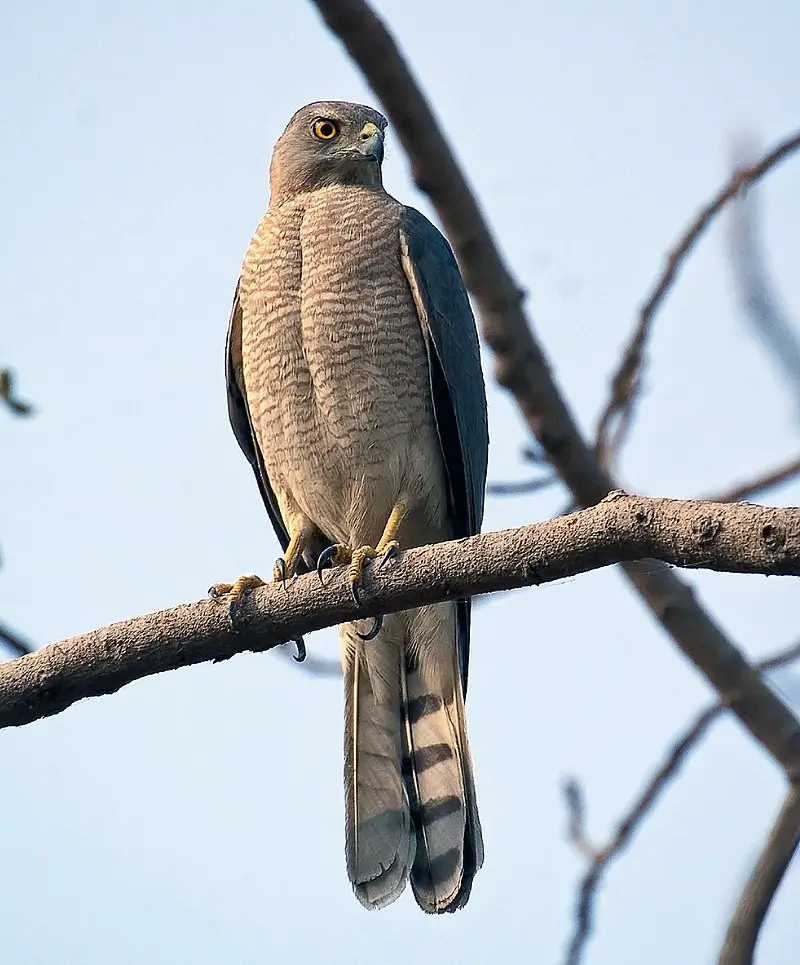
The Shikra bird, also known as the little banded goshawk, is a widespread bird of prey found in Asia and Africa. It is a small species belonging to the Accipitridae family.
The African variations of the Shikra may potentially represent a distinct species, but they are usually considered subspecies.
This bird has physical similarities to other sparrowhawk species, such as the Chinese Goshawk and Eurasian Sparrowhawk.
The Shikra is a quick predator and possesses excellent hunting skills. It typically preys on small mammals, reptiles, and birds.
The bird is known for its distinctive hunting technique, which involves a sudden dash and a quick silent strike to capture its victim.
Its plumage consists of brown or greyish-brown feathers with white and fine black streaks.
Overall, the Shikra bird is an impressive bird of prey, known for its versatility and hunting prowess.
Scientific classification:
| Kingdom | Animalia |
| Phylum | Chordata |
| Class | Aves |
| Order | Accipitriformes |
| Family | Accipitridae |
| Genus | Accipiter |
| Species | A. badius |
Also Featured In: Birds That Live in the Jungle, Native Birds of Kazakhstan
30. Brown-Headed Barbet
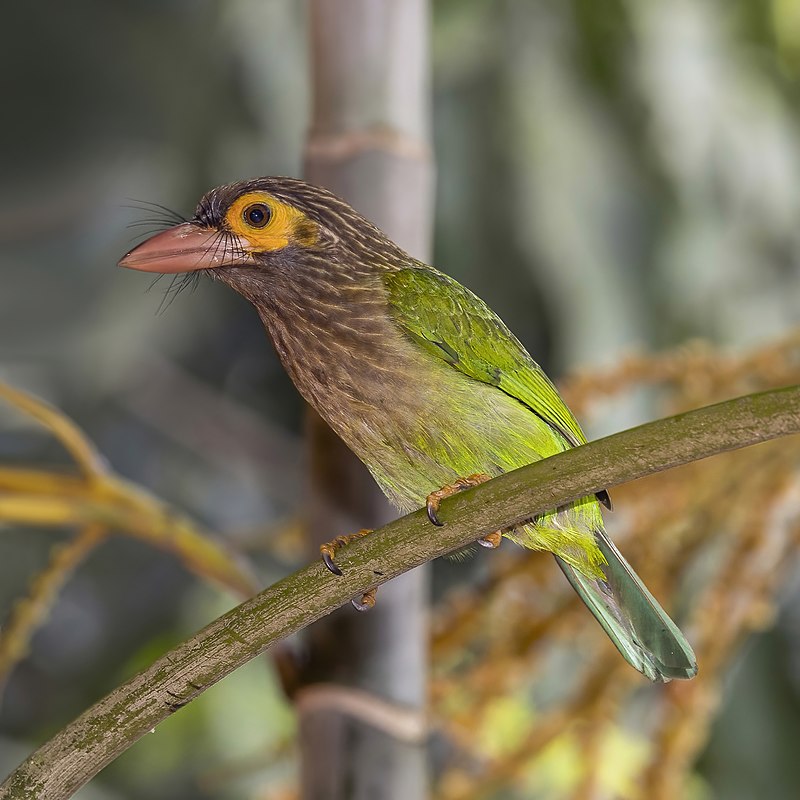
The Brown-headed barbet is an Asian bird that lives in the moist broadleaf forests of the Indian subcontinent. Johann Friedrich Gmelin described it in 1788 as part of the puffbird family.
The Brown-headed barbet has a distinct brown head and a green body. They are known for their distinctive calls, which can be heard echoing through the forests.
These birds feed on insects and fruits, using their strong beaks to break open nuts and seeds.
They are cavity nesters, making their homes in holes in trees. The Brown-headed barbet is considered a species of least concern, although its habitats are threatened by deforestation and human activities.
Their colorful appearance and unique calls make them a delight for birdwatchers to spot in the wild.
Scientific classification:
| Kingdom | Animalia |
| Phylum | Chordata |
| Class | Aves |
| Order | Piciformes |
| Family | Megalaimidae |
| Genus | Psilopogon |
| Species | P. zeylanicus |
Also Featured In: Birds of Goa, Delhi Birds You Need to See
31. Spotted Owlet
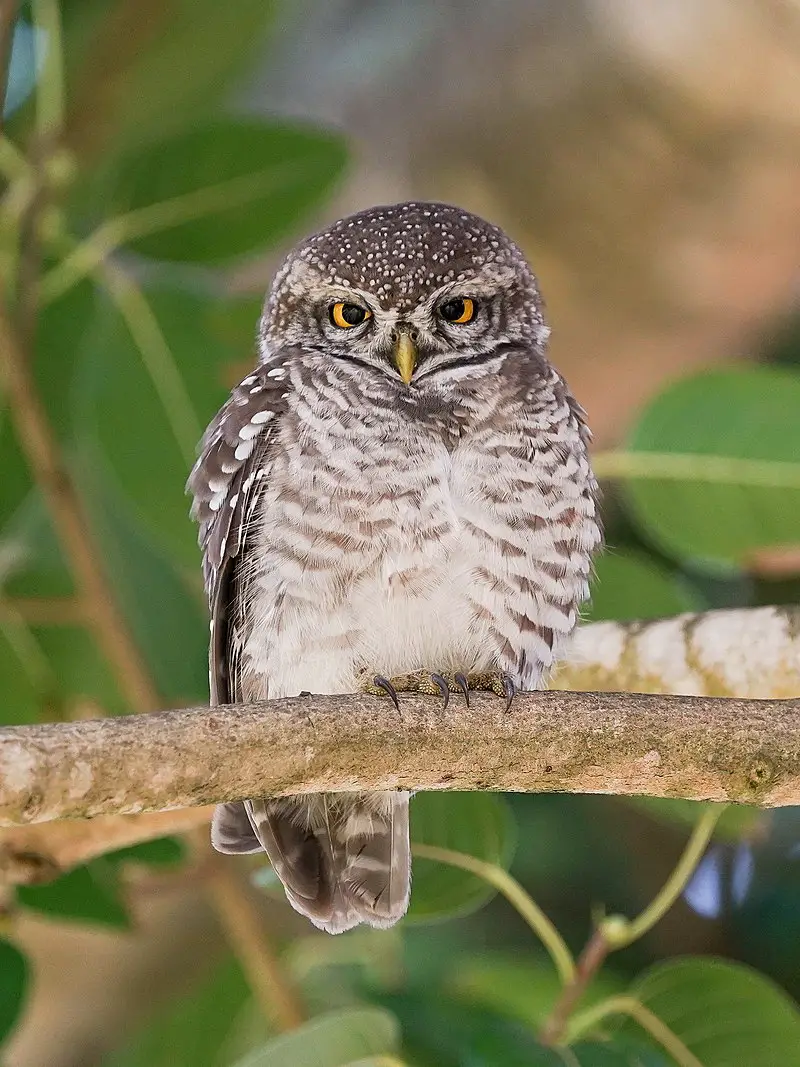
The Spotted owlet, also known as Athene brama, is a small bird species found in tropical Asia, from mainland India to Southeast Asia. It is a common resident of open habitats, including farmland and human habitation.
This bird has adapted well to living in urban areas and can be found roosting in small groups in cavities of trees, rocks or buildings.
They typically nest in holes in trees or buildings and lay 3-5 eggs. The Spotted owlet has shown great adaptability to changing environments and has learned to coexist with humans in urban settings.
This bird is known for its distinctive spotted appearance and has become a well-loved sight in many parts of Asia.
Scientific classification:
| Kingdom | Animalia |
| Phylum | Chordata |
| Class | Aves |
| Order | Strigiformes |
| Family | Strigidae |
| Genus | Athene |
| Species | A. brama |
Also Featured In: Common Birds in Bangalore, Common Birds of Maharashtra
32. Crested Goshawk
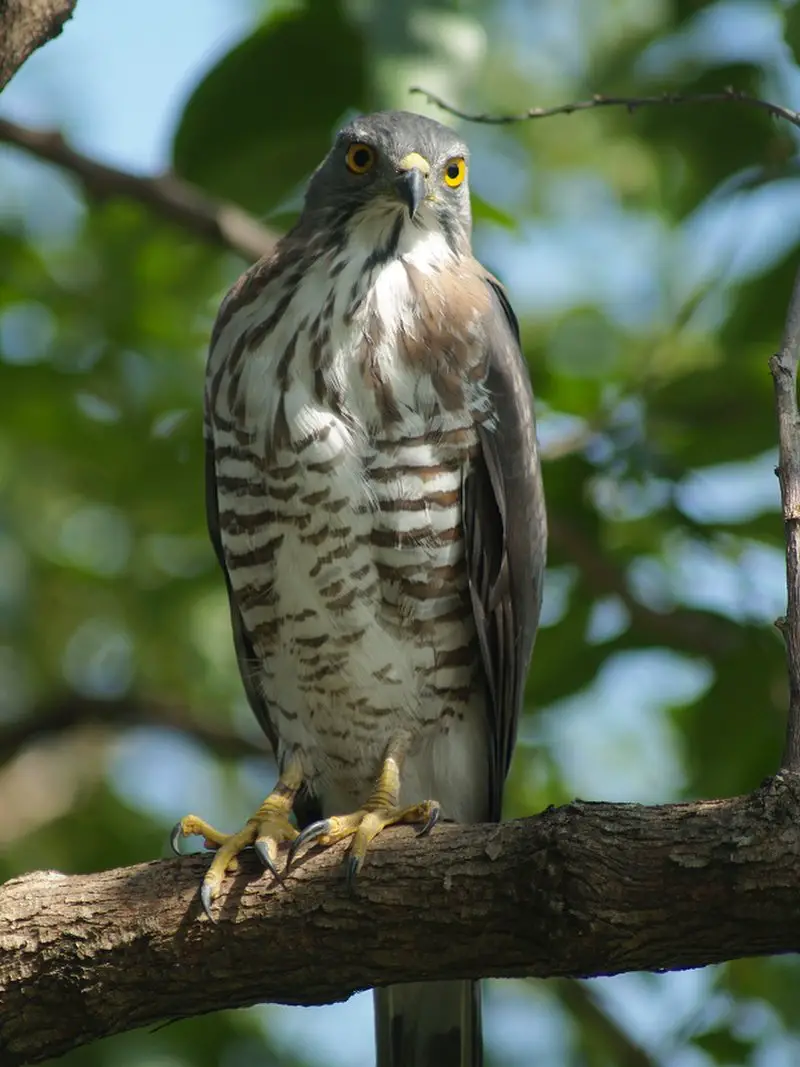
The Crested Goshawk bird is a diurnal raptor found in tropical Asia. Belonging to the Accipitridae family, it shares characteristics with buzzards, harriers, and eagles.
Its wings are short and broad, with a long tail, aiding in its movement through trees. The larger female Crested Goshawk can grow up to 46 cm in length, much bigger than the male.
These birds are skilled hunters and have adapted well to their forest habitats, using their sharp talons and beaks to catch prey.
Despite their ferocity, Crested Goshawks are still threatened by habitat destruction across Asia, rendering them vulnerable in many regions.
Overall, the Crested Goshawk bird is a graceful predator that perfectly exemplifies the beauty and ferocity of the natural world.
Scientific classification:
| Kingdom | Animalia |
| Phylum | Chordata |
| Class | Aves |
| Order | Accipitriformes |
| Family | Accipitridae |
| Genus | Accipiter |
| Species | A. trivirgatus |
Also Featured In: Most Common Taiwan Birds, Ko Mak Birds You Didn’t Know
33. Scarlet Minivet
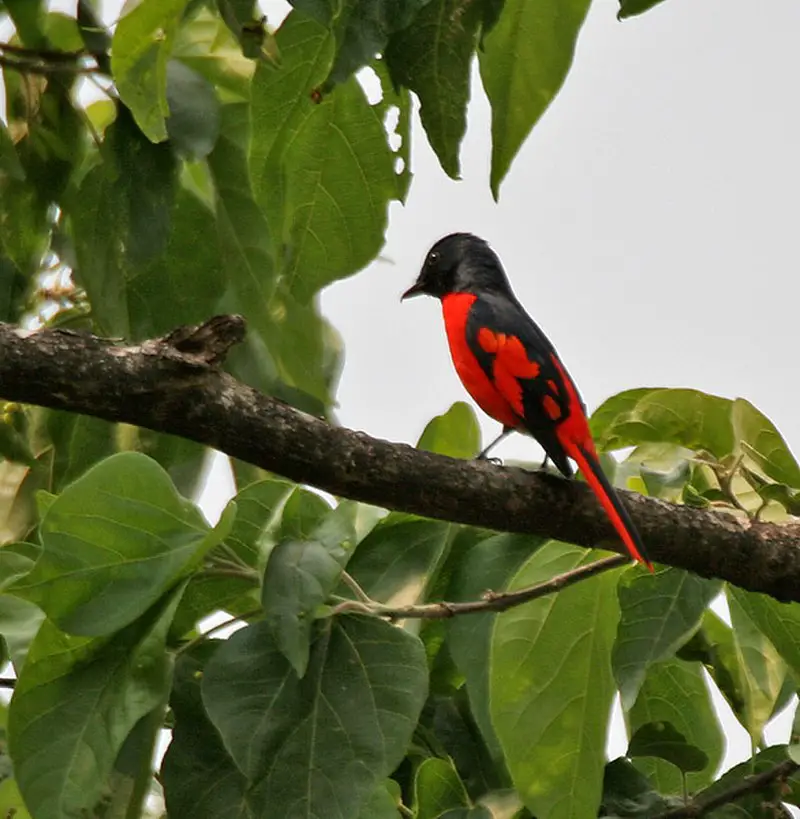
The Scarlet Minivet is a tiny bird species that is commonly found in tropical regions of southern Asia. It is a resident breeding bird and prefers well-wooded habitats like forests and gardens.
The male species has a bright orange or scarlet color with a black upper part. It is a common sight in hilly regions of Northeast India to southern China, Indonesia, and the Philippines.
The bright color of the male makes it easy to identify this species when compared to the female, whose coloring is not as vibrant.
Scarlet Minivets can often be heard singing their melodious songs in the forests, making them a favorite among birdwatchers.
Scientific classification:
| Kingdom | Animalia |
| Phylum | Chordata |
| Class | Aves |
| Order | Passeriformes |
| Family | Campephagidae |
| Genus | Pericrocotus |
| Species | P. speciosus |
Also Featured In: Hong Kong Birds You Need to See, Birds You’ll Find in Kanha National Park
34. Jungle Owlet
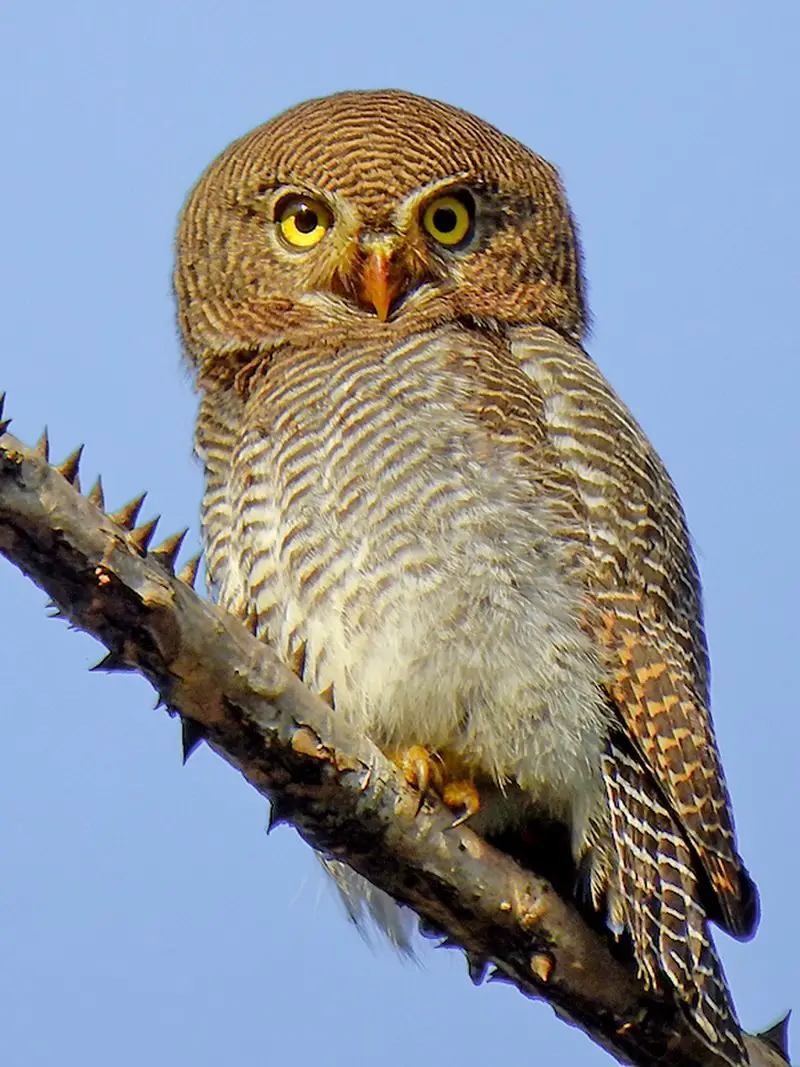
The jungle owlet is a small bird that is native to the Indian Subcontinent. It is also known as the barred jungle owlet and is often found alone or in small groups.
Their calls are heard at dawn and dusk. There are two subspecies of the jungle owlet, with the one found in the Western Ghats potentially being a separate species. They have a rounded head and are finely barred all over.
Scientific classification:
| Kingdom | Animalia |
| Phylum | Chordata |
| Class | Aves |
| Order | Strigiformes |
| Family | Strigidae |
| Genus | Glaucidium |
| Species | G. radiatum |
Also Featured In: Gujarati Birds, Common Birds in Kerala
35. Chestnut-Headed Bee-Eater
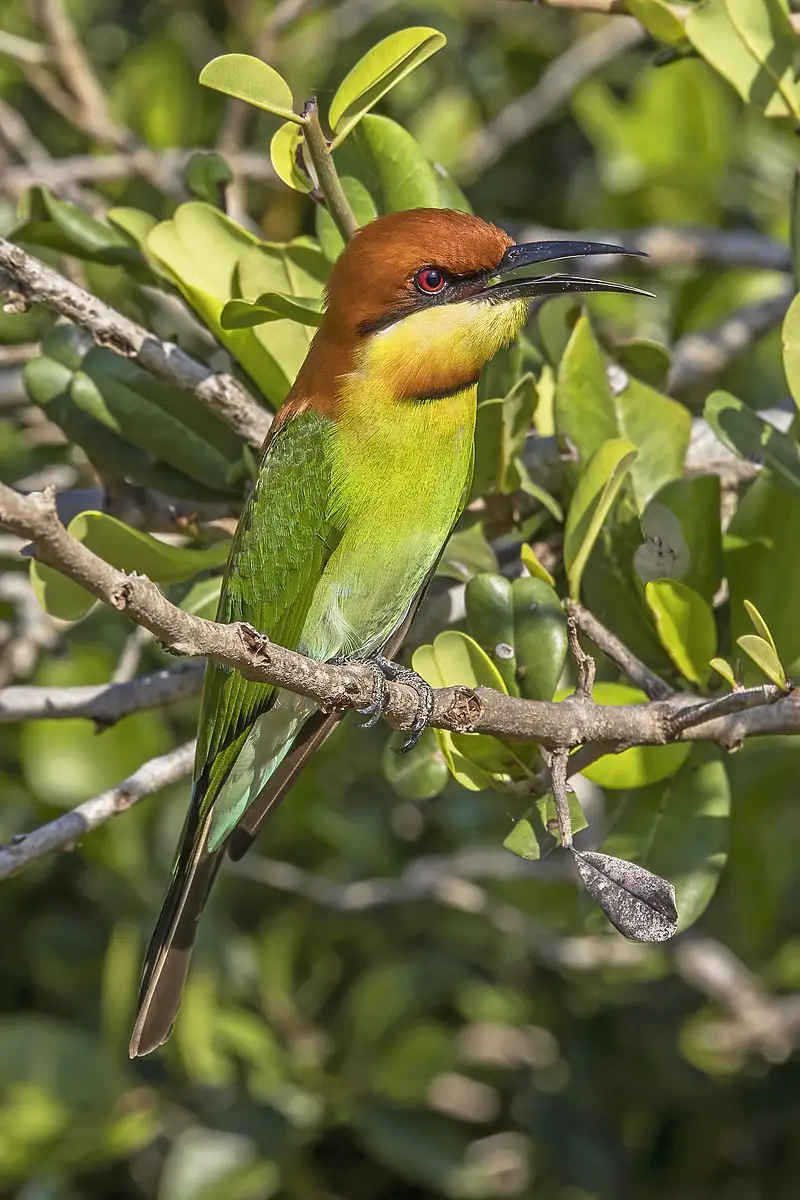
The Chestnut-headed bee-eater is a vibrantly colourful bird found in the Indian subcontinent and neighbouring regions. It belongs to the bee-eater family and is a resident breeder.
The bird is slender and has a predominantly green body, along with blue on the rump and lower belly. The bird’s chestnut head is its most distinguishing feature, which gives it its name.
The bird’s beak is long, pointed and slightly curved, ideal for catching insects, its primary food. These birds prefer living in open and wooded habitats like gardens and deciduous forests.
They are known for their swift flight and have the ability to catch insects while airborne. These birds have a unique nesting behaviour, where they use their beaks to excavate holes in vertical sandbanks or similar substrates.
Despite their beauty and unique characteristics, these birds are vulnerable to habitat loss and deforestation, making conservation efforts more critical than ever.
Scientific classification:
| Kingdom | Animalia |
| Phylum | Chordata |
| Class | Aves |
| Order | Coraciiformes |
| Family | Meropidae |
| Genus | Merops |
| Species | M. leschenaulti |
36. Crested Treeswift
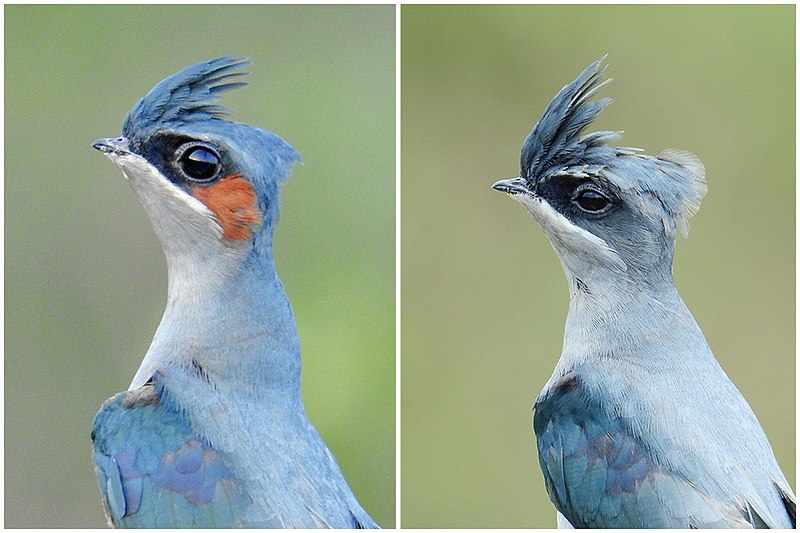
The crested treeswift bird is a species of tree swift and is distinct in flight with its long, bowed wings and deeply forked tail.
It is often confused with its eastern relative, the gray-rumped treeswift, but they do not interbreed where their ranges overlap.
This bird has a pointed appearance and can be recognized by its crested head. The crested treeswift is a large bird that is known for its ability to fly long distances with ease.
It is often found in forested areas and feeds on insects which it catches while in flight.
This bird is a beautiful addition to any natural environment and is a joy to observe in flight.
Scientific classification:
| Kingdom | Animalia |
| Phylum | Chordata |
| Class | Aves |
| Clade | Strisores |
| Order | Apodiformes |
| Family | Hemiprocnidae |
| Genus | Hemiprocne |
| Species | H. coronata |
37. River Tern
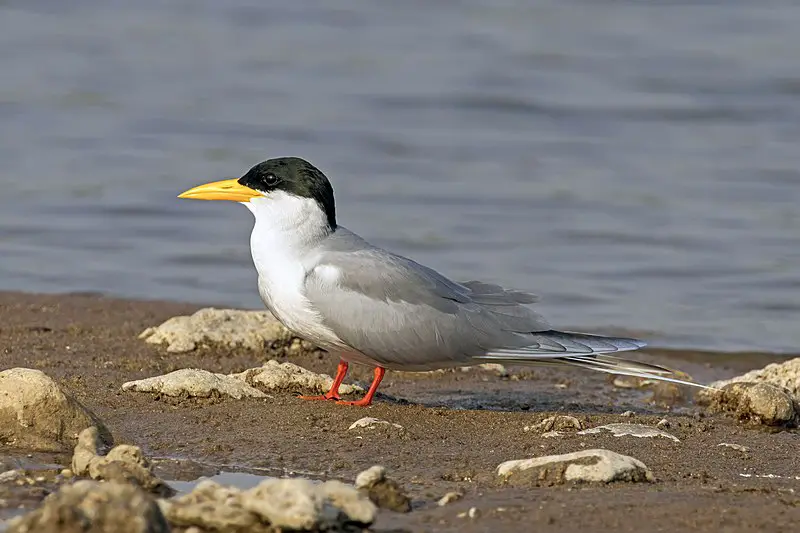
The River tern bird, scientifically known as Sterna aurantia, is a member of the Laridae family. It resides along inland rivers in the Indian Subcontinent, Iran, and eastern Myanmar to Thailand.
This bird is uncommon in Thailand. It is known for living almost exclusively in freshwater, contrary to other species in the same family.
Usually quiet when away from breeding grounds, River terns become vocal during their breeding period, which ranges from March to May.
The River terns build their nests in colonies.
Scientific classification:
| Kingdom | Animalia |
| Phylum | Chordata |
| Class | Aves |
| Order | Charadriiformes |
| Family | Laridae |
| Genus | Sterna |
| Species | S. aurantia |
Also Featured In: Birds that Live in Rajasthan, Most Common Madhya Pradesh Birds
38. White-Browed Fantail
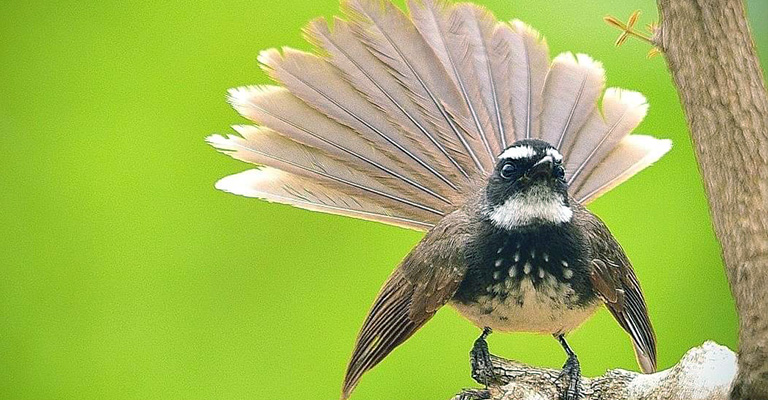
The White-browed fantail bird is a member of the Rhipiduridae family and is quite small, measuring only 18 cm in length. Its upperparts are dark brown, and it has white spots on its wings.
The underparts are whitish, and the tail is fan-shaped and has white edges. On its forehead, the long white supercilia meet, and the throat and eyemask are blackish and bordered with a whitish moustache.
This bird’s appearance is unique, and it is a delight to see in nature.
Scientific classification:
| Kingdom | Animalia |
| Phylum | Chordata |
| Class | Aves |
| Order | Passeriformes |
| Family | Rhipiduridae |
| Genus | Rhipidura |
| Species | R. aureola |
39. White-Bellied Drongo
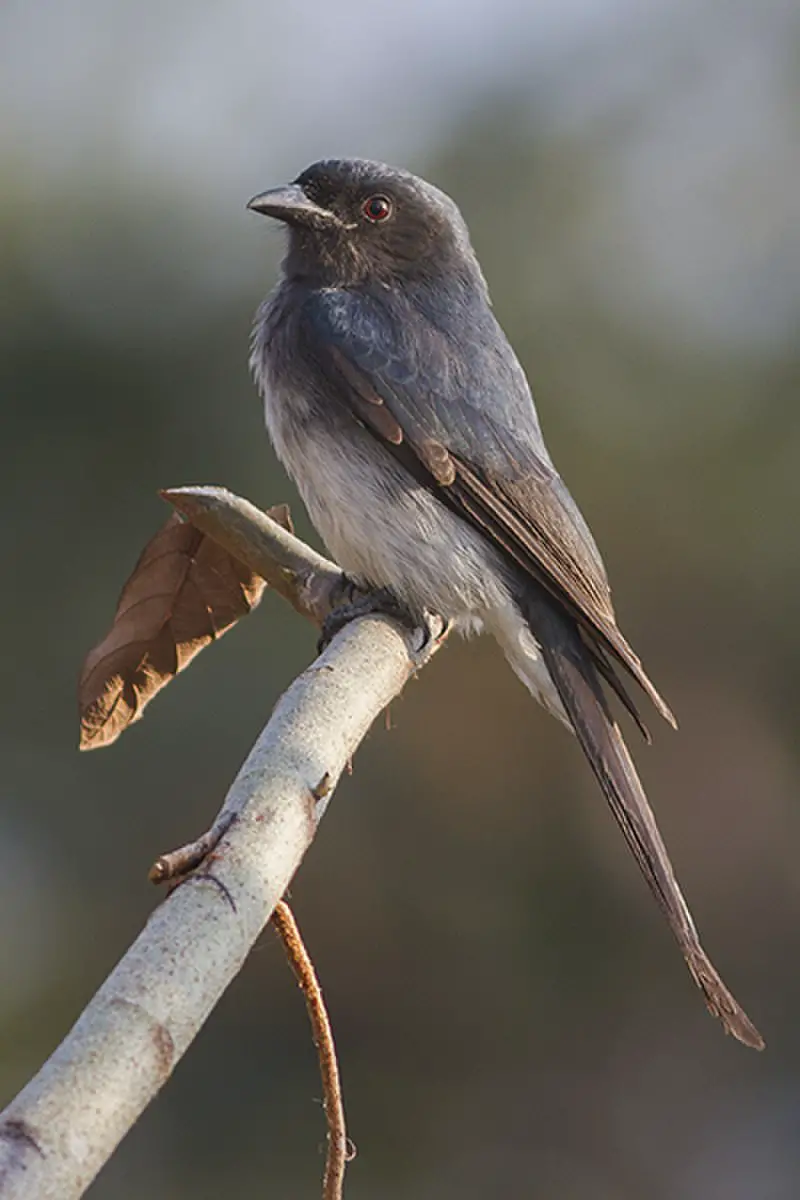
The white-bellied drongo bird is native to the Indian Subcontinent and belongs to a family of insect-eating birds called Dicruridae.
It is mostly black in color with a white belly and vent, but its young ones are completely black and can be easily confused with the black drongo, which is smaller in size.
The bird is often seen hopping around in trees and bushes, hunting for insects to feed on. It has a distinct, chattering call that can be heard from a distance.
The white-bellied drongo is relatively common and enjoys a wide range of habitats, from forests to open fields.
It is an important part of the ecosystem, controlling insect populations and participating in seed dispersal.
Despite being a commonly found species, it is still a beautiful and intriguing bird to spot in the wild.
Scientific classification:
| Kingdom | Animalia |
| Phylum | Chordata |
| Class | Aves |
| Order | Passeriformes |
| Family | Dicruridae |
| Genus | Dicrurus |
| Species | D. caerulescens |
Also Featured In: Endemic Sri Lanka Birds,
40. Golden-Fronted Leafbird
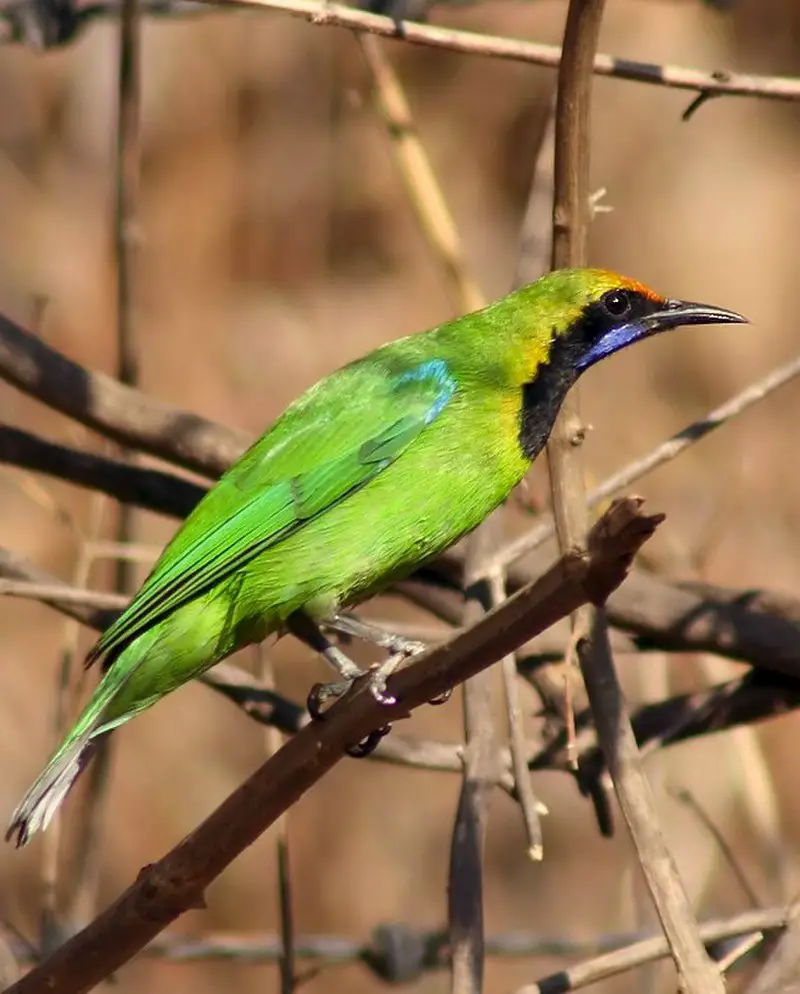
The Golden-fronted leafbird, also known as Chloropsis aurifrons, can be found in various regions such as the Indian subcontinent, south-western China, south-east Asia, and Sumatra.
Known for building their nests in trees and laying around 2-3 eggs, this species primarily feeds on insects and berries.
It is notable that the Sumatran leafbird was once considered a subspecies, but the two have distinct differences in their morphology and traits.
With its beautiful golden-fronted appearance, this bird is a magnificent sight to see in the wild.
Scientific classification:
| Kingdom | Animalia |
| Phylum | Chordata |
| Class | Aves |
| Order | Passeriformes |
| Family | Chloropseidae |
| Genus | Chloropsis |
| Species | C. aurifrons |
41. Malabar Trogon
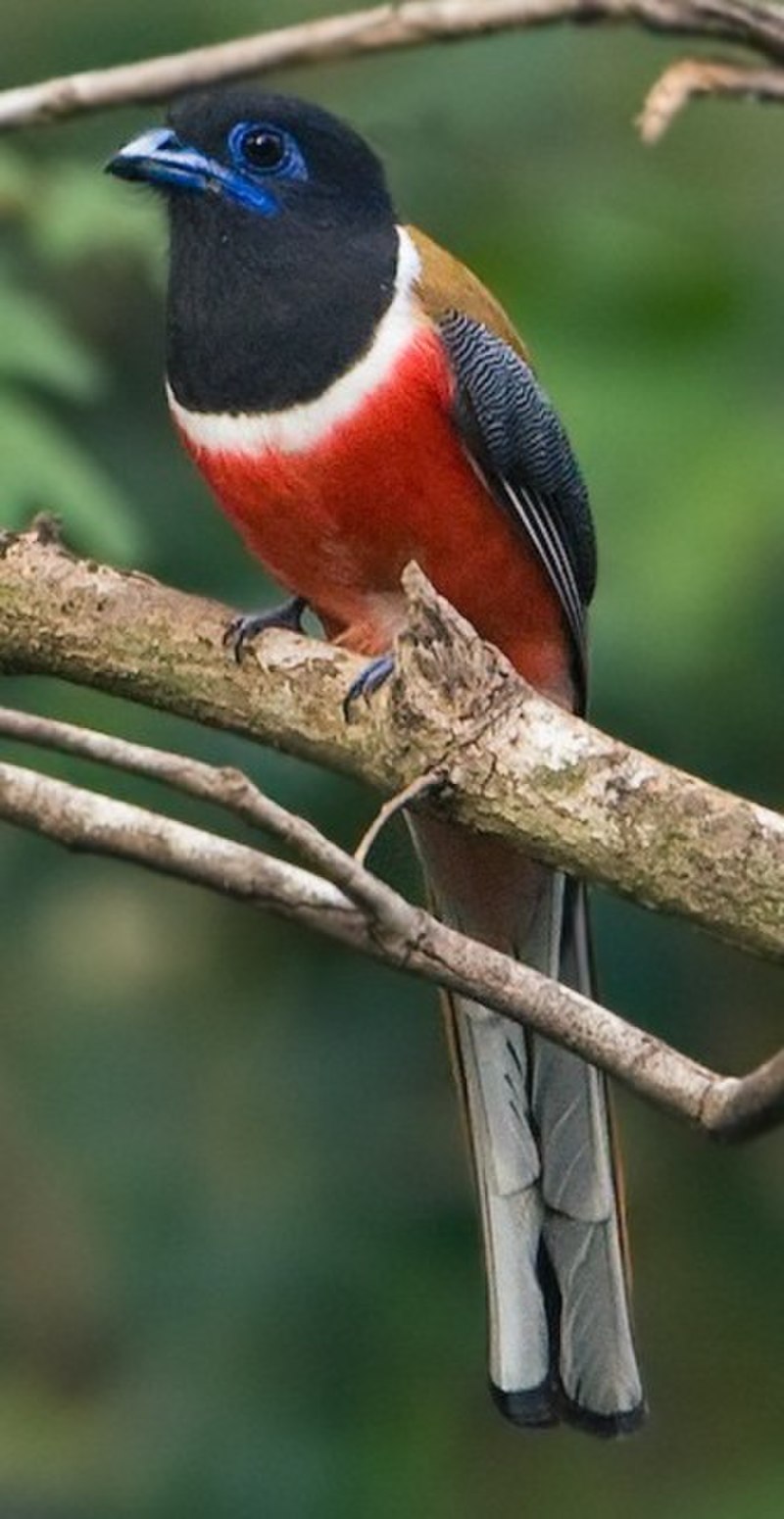
The Malabar trogon bird is a member of the trogon family found in Sri Lanka and peninsular India. It prefers living in the forests of the Western and Eastern Ghats and the hill forests of central India.
These insectivorous birds are known to move seasonally in response to rain in hill forest regions.
They are not migratory, meaning they do not travel long distances every year. Malabar trogons have unique characteristics that distinguish them from other birds.
They are known for their bright colors and long tails, which contribute to their distinct appearance.
These birds are important members of the ecosystem as they contribute to the control of insect populations in their habitat.
Scientific classification:
| Kingdom | Animalia |
| Phylum | Chordata |
| Class | Aves |
| Order | Trogoniformes |
| Family | Trogonidae |
| Genus | Harpactes |
| Species | H. fasciatus |
42. Rosy Minivet
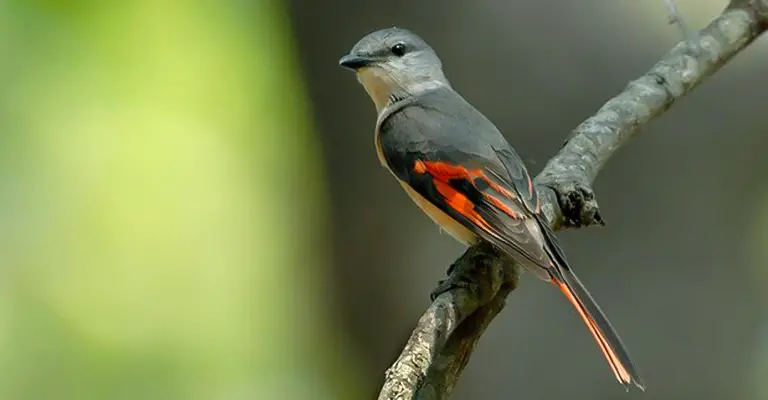
The Rosy Minivet is a type of bird that belongs to the Campephagidae family. This species can be identified by the pink or light red shade on the wings and tail of the males, while the females have an olive or olive-yellow rump that sets them apart from other minivets with bright yellow coloring.
Both male and female birds have grey feathers above. The Rosy Minivet can be found in various countries, including Afghanistan, Bangladesh, Bhutan, China, India, Laos, Myanmar, and Nepal.
These birds are known for their striking colors and are a fascinating sight for bird enthusiasts. They have a unique appearance that distinguishes them from other birds in the family.
The Rosy Minivet’s unique features are an adaptation to their natural habitat and play an important role in their survival.
Scientific classification:
| Kingdom | Animalia |
| Phylum | Chordata |
| Class | Aves |
| Order | Passeriformes |
| Family | Campephagidae |
| Genus | Pericrocotus |
| Species | P. roseus |
43. Indian Nightjar
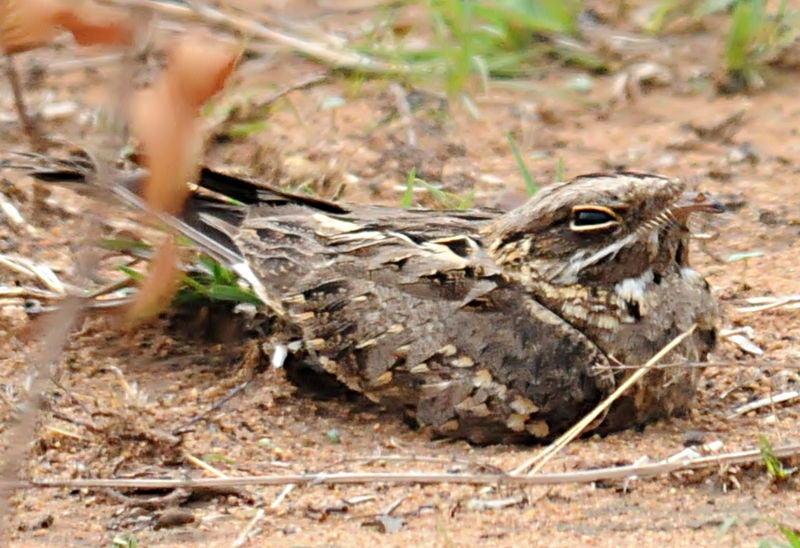
The Indian nightjar is a tiny bird that inhabits open areas in South and Southeast Asia. It is known for its nocturnal habits and distinct calls, which resemble the sound of a stone skipping on ice.
This bird is crepuscular, meaning that it is most active during dawn and dusk. Although it is not often seen, it can be identified by its unique clicking calls.
The Indian nightjar is a resident breeder, which means it stays in one area year-round and breeds there.
This bird chooses its habitat carefully, preferring open landscapes where it can easily find insects to feed on during the night.
Overall, the Indian nightjar is a fascinating and elusive bird that adds to the diversity of birdlife in Asia.
Scientific classification:
| Kingdom | Animalia |
| Phylum | Chordata |
| Class | Aves |
| Clade | Strisores |
| Order | Caprimulgiformes |
| Family | Caprimulgidae |
| Genus | Caprimulgus |
| Species | C. asiaticus |
Also Featured In: Birds that Live in Tamil Nadu, Birds of Andhra Pradesh
44. Common Woodshrike
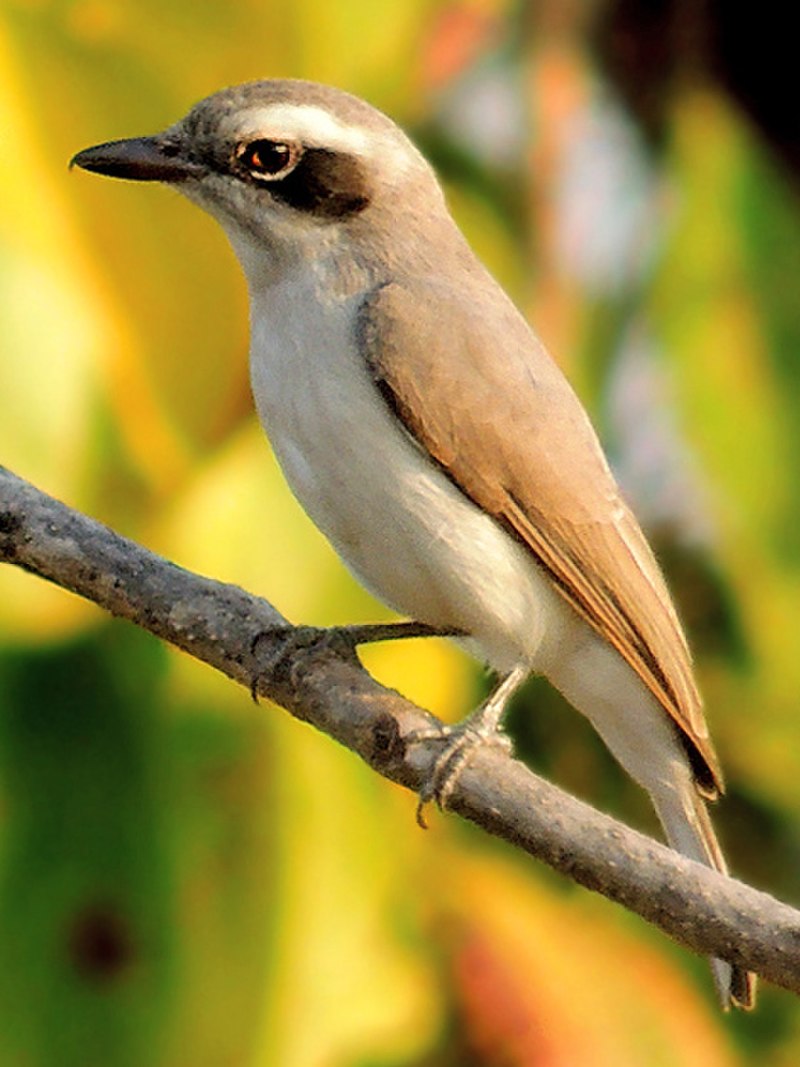
The Common woodshrike bird is a small, ashy brown species found across Asia. It has a distinctive dark cheek patch and broad white brow.
Normally found in thin forests and scrub habitats, they are known to hunt insects as their primary diet, occasionally joining other insectivorous birds.
Native to Sri Lanka, they were previously classified under the family Vangidae. Despite their small size, they have striking features that make them stand out.
The Common woodshrike bird is a unique and intriguing species that deserves our attention and appreciation.
Scientific classification:
| Kingdom | Animalia |
| Phylum | Chordata |
| Class | Aves |
| Order | Passeriformes |
| Family | Vangidae |
| Genus | Tephrodornis |
| Species | T. pondicerianus |
45. Large-Tailed Nightjar
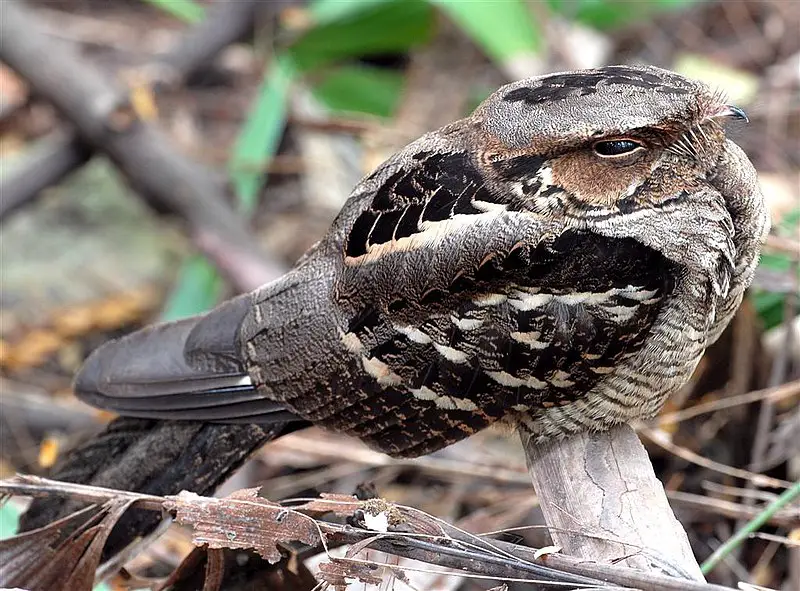
The Large-tailed nightjar is a species of bird from the Caprimulgidae family. It is a resident in countries such as Australia, Bangladesh, China, India, Indonesia, and many more.
The bird is found along the southern Himalayan foothills, eastern South Asia, Southeast Asia, and northern Australia. It has a unique appearance with a large tail, which is where it gets its name.
The Large-tailed nightjar is a nocturnal bird, thus active during the night. It feeds on insects, which it captures while flying. This species has a vast range, and its population size is believed to be stable.
The bird’s presence adds to the biodiversity of the regions it inhabits.
Scientific classification:
| Kingdom | Animalia |
| Phylum | Chordata |
| Class | Aves |
| Clade | Strisores |
| Order | Caprimulgiformes |
| Family | Caprimulgidae |
| Genus | Caprimulgus |
| Species | C. macrurus |
Also Featured In: Birds You’ll Find in Night,
46. Black-Headed Cuckooshrike
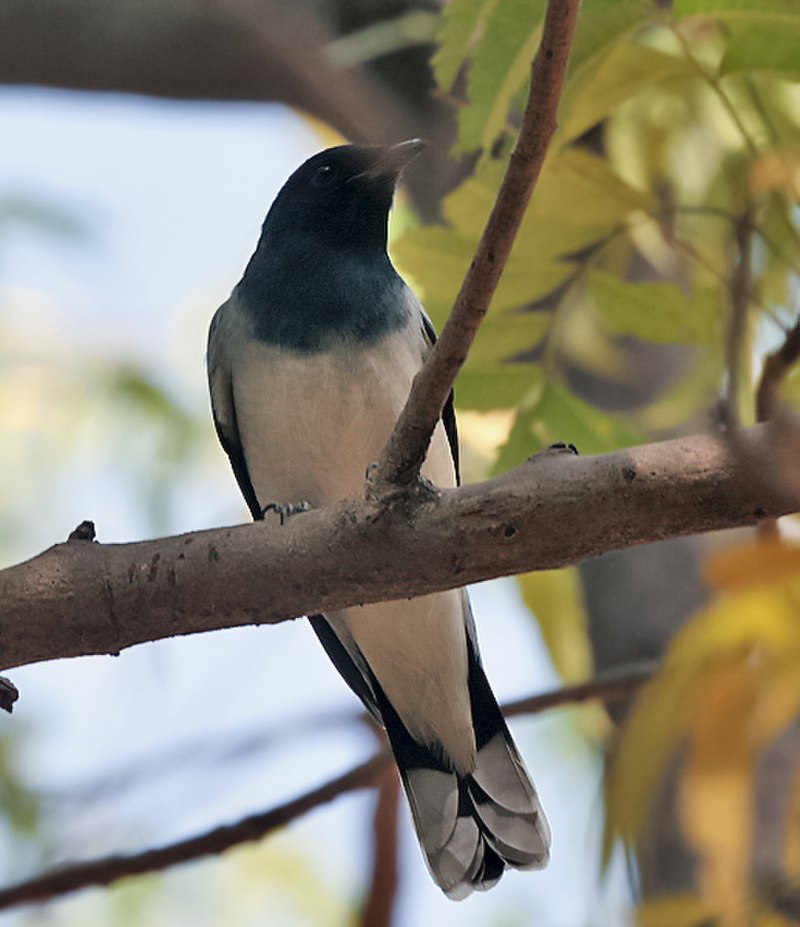
The Black-headed cuckooshrike is a bird species found in the Indian Subcontinent and Southeast Asia.
Males and females have different appearances, with the male having a black head and white underparts and the female being brownish-gray with a white belly.
They inhabit trees in forests and gardens, and feed on insects and berries. These birds are known for their beautiful songs and can often be heard singing loudly in the morning.
They are also known to be aggressive towards other bird species, and will defend their territory fiercely.
Their conservation status is listed as Least Concern, although habitat loss and fragmentation may pose a threat to their population in the future.
Scientific classification:
| Kingdom | Animalia |
| Phylum | Chordata |
| Class | Aves |
| Order | Passeriformes |
| Family | Campephagidae |
| Genus | Lalage |
| Species | L. melanoptera |
Also Featured In: Birds that You’ll Find in Kolkata,
47. Pale-Capped Pigeon
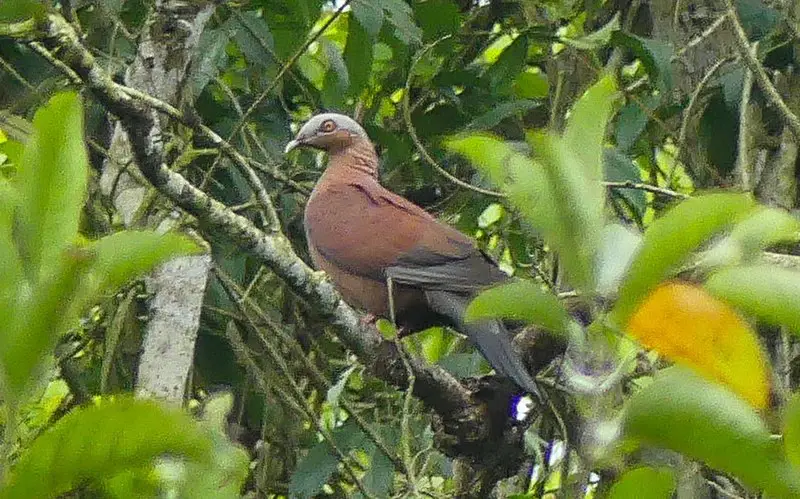
The pale-capped pigeon, also called the purple wood pigeon, is a substantial bird species found throughout parts of Southeast Asia and the Indian subcontinent.
They have a leisurely flight and tend to rest in the foliage of large fruiting trees, mostly in riverine forest areas.
Their coloring is mainly brown on top and chestnut below, with a glossy patch on the head that appears purple in some lighting.
The bird’s slow movements and shy nature make it challenging to spot in the wild. Despite their patchy distribution, this species is not currently considered to be in danger of extinction.
Scientific classification:
| Kingdom | Animalia |
| Phylum | Chordata |
| Class | Aves |
| Order | Columbiformes |
| Family | Columbidae |
| Genus | Columba |
| Species | C. punicea |